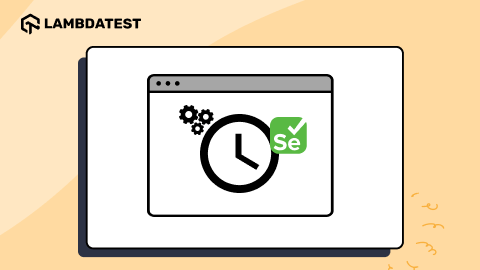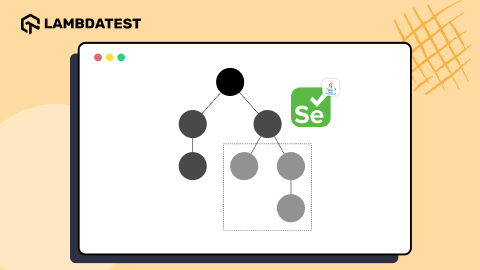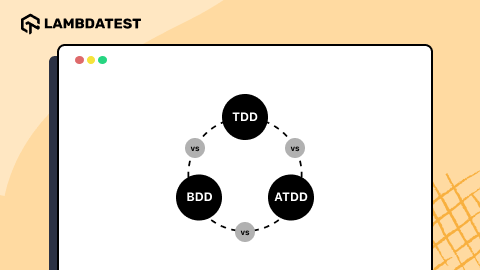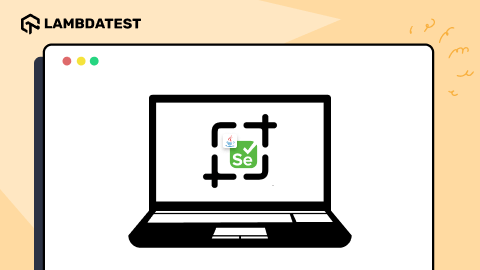Complete Guide To Automation Testing Frameworks [2024]
Bhawana
Posted On: February 19, 2024
![]() 169709 Views
169709 Views
![]() 44 Min Read
44 Min Read
The success of any automation testing depends on testing frameworks. Testing and maintenance expenses must be reduced for QA teams aiming to optimize their agile processes and offer a more substantial ROI on test automation.
Testing frameworks play an essential role in any automated testing workflow. They can save you money on maintenance and testing efforts and will give you a better ROI if you’re a QA team looking to optimize your Agile processes.
In this article, we will learn about the best automation testing frameworks currently in use and the pros and cons of each. Whether you’re an experienced automated testing or software testing professional or just need a refresher, we’ll walk you through each type of testing framework and how it can help you get the most out of your automated testing workflow.
Perfect, let’s dive right in!
TABLE OF CONTENTS
What is an Automation Testing Framework?
Automation testing frameworks are guidelines or standards for designing and writing effective test cases.
The general guidelines for automation testing frameworks include object repositories, coding standards that you can avoid manually entering, test data handling strategies and advantages, and storage that is easily accessible for the derived test data results. They also include any additional information that may be needed to run the tests appropriately.
Testers can still write or record tests without adhering to these standards. However, adopting an organized framework offers extra benefits that would otherwise be missed. Therefore, using a practical automation testing framework can improve software quality by quickly identifying bugs early, thus reducing the time and effort required to perform manual testing.
Benefits of a Test Automation Framework
Automation testing frameworks have become essential in modern software development and testing processes as they allow the code to be reused in different scenarios and help write standardized test scripts for the team. Test automation frameworks also help to avoid human intervention, improve test coverage, and promote team collaboration.
It helps repeatedly run the same test scripts with various builds to analyze the application and verify the output. Overall, using an automation testing framework is critical to a comprehensive software quality assurance strategy that takes care of every problem.
Some advantages of adopting an automated testing framework:
- Code reusability: The valuable data is kept for later use and can be reused anytime. These frameworks include the necessary coding data for the automation test to succeed. It is optional to enter codes or rearrange them manually. You can use the code to do more automation tests as well.
- Low maintenance cost: Compared to manual testing, automation testing involving different frameworks is more cost-effective because it makes it easier to accept upgrades or modifications to the application by updating the existing reusable components. It reduces maintenance expenses.
- Continuous testing: Guarantees that code is continuously tested throughout its lifecycle to help identify and resolve bugs early.
- Minimal manual interference: Automation testing frameworks reduce the need for manual intervention by executing test scripts, ensuring a more efficient and error-free testing process.
- Improved efficiency: Automation increases testing productivity by expediting the entire Software Testing Life Cycle (STLC), enabling faster feedback on software quality, and quickly completing repetitive jobs.
- Maximum test coverage: Automation testing frameworks help achieve full test coverage by facilitating the investigation of many situations and guaranteeing an exhaustive program assessment under various circumstances.
- Consistent strategy throughout test suites: With automated testing, a consistent test strategy is maintained across various test suites, ensuring uniformity and reliability in assessing the software’s functionality and performance.
- Resource optimization: It helps optimize resources, i.e., making it easier to utilize various resources under organizational requirements.
- Structured development: It offers a structured development technique to guarantee design consistency and reduce dependence on test cases.
- Accurate RCA: It provides accurate root-cause analysis with the most minor human intervention.
- Parallel Testing: It supports parallel testing on browsers, devices, and platform combinations.
Types of Automation Testing Framework
There are six popular categories of automation testing frameworks, each with a unique design and set of advantages and drawbacks. You can use one or more of the following automation testing frameworks for your tests.
- Modular-Driven Automation Testing Framework
- Data-Driven Automation Testing Framework
- Linear Automation Testing Framework
- Keyword-Driven Testing Framework
- Hybrid Testing Framework
- Library Architecture Testing Framework

Modular-Driven Automation Testing Framework
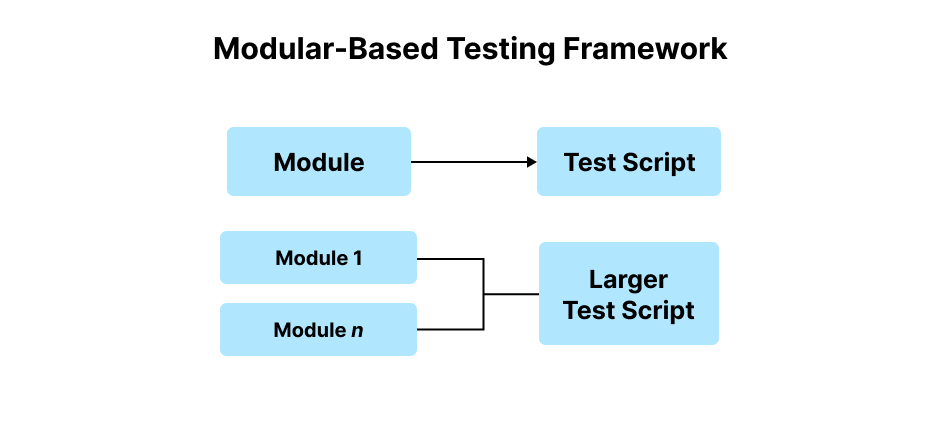
Specific modules must be present for the modular-driven automation testing framework to function. To get the best results from the automation test, you need to develop different scripts for each module and work with them.
- Modules will not be impacted if the application’s operation is changed.
- Test scripts are safe unless they are manually changed.
- A high level of modularization is produced by merging multiple modules, providing a cost-effective management approach.
- After writing a script, QA professionals can save it in the function library.
Advantages:
- Reusability of code
- Scalability
- Highly efficient
- Modular approach
Disadvantages:
- Increased complexity
- Lack of flexibility
- Need technical knowledge
Data-Driven Automation Testing Framework
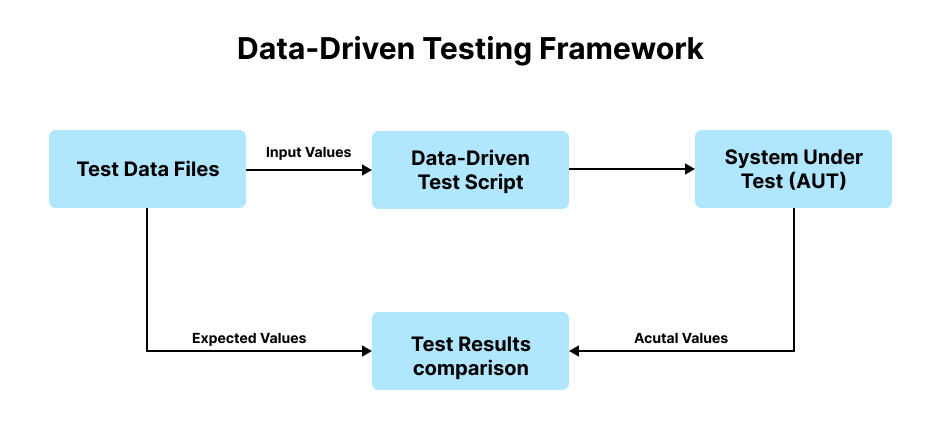
Testers are free to store test data, as the test data and script logic are separated using a data-driven testing framework. A situation arises for testers where there is a requirement to test a feature or function of an application several times with different sets of data. This testing framework makes it easy as the test data does not require hard-coded scripts.
Through a data-driven automation testing framework, testers can store and pass input/output parameters to test scripts from an external data source, such as Excel spreadsheets, text files, CSV files, SQL tables, or ODBC repositories.
Advantages:
- Fast test speed
- Highly scalable
- Better flexibility
- Need fewer test scripts
Disadvantages:
- Increased setup time
- High-level technical knowledge is required
- Troubleshooting is burdensome
Linear Automation Testing Framework
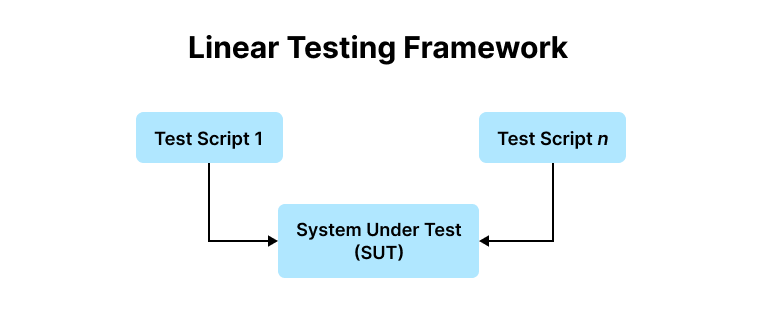
Unlike the previous linear automation testing framework, scripting is performed manually by a single person who meticulously documents each stage of the procedure. It is commonly known as the “record and playback” framework and requires much time to run.
It may be a simple recording approach and does not require automation skills, but it does not allow script reuse. To execute the framework in the future, you would need to manually code the test script, which adds time to the maintenance process.
Advantages:
- Simplicity
- Fast execution speed
- Highly flexible
Disadvantages:
- High maintenance
- More redundant
- Single-use
Keyword-Driven Automation Testing Framework

Keywords in the scripts represent various actions taken to test the graphical user interface of an application. These keywords are sometimes labeled with straightforward terms like “click” or “login,” and other times, they are labeled with more sophisticated terminology like “verifying” or “clicklink.”
With this method, keywords must be saved alongside the related object or user interface (UI) that calls for a specific action. A shared object repository maps objects to the necessary actions for a keyword-driven testing framework. It should be noted that the produced keywords apply to many test scripts.
The keyword-driven framework outlines several preset methods and actions. Teams with a diversified background in coding tend to favor keywords. For instance, in a QA team with one developer and three manual testers, the assigned developer would be responsible for creating the keywords for which the manual testers would need to write tests.
Advantages:
- Improved reusability
- Low maintenance
- More scalable
Disadvantages:
- Complexity increases over time
- High development time
- It requires deep automation testing knowledge
Hybrid Automation Testing Framework
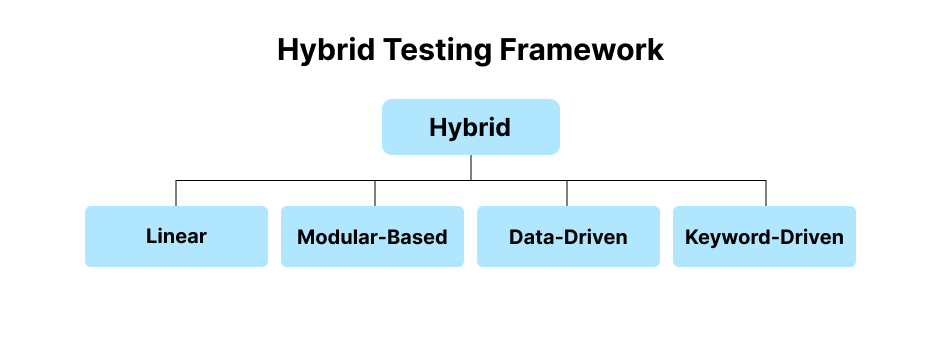
All other test framework types are combined in a hybrid test automation framework to give QA teams an efficient testing method that saves time and cost. It improves testing efficiency by reducing the drawbacks of each test framework and combining their benefits. Hybrid frameworks successfully handle every issue that testers identify during the testing process, which is a sign that test automation is becoming increasingly necessary.
Every application is unique, and testing procedures should be, too. A flexible automation testing framework must be established as more teams switch to an agile approach. A hybrid framework is critical to achieve the most significant test results.
Advantages:
- Faster test execution
- High scalability
- Reduced costs
Disadvantages:
- Highly complex, i.e., requires advanced technical knowledge
- Requires fully scripted tests
Library Architecture Automation Testing Framework

A library architecture automation testing framework identifies tasks that share characteristics within each test script, making it possible for testers to group similar tasks according to the function kept in a library. It makes it easier for code to be reused across various test scripts. This framework is helpful when the application’s different components have similar functionalities.
Advantages:
- High reusability
- Cost-effective
- Improved scalability
- High long-term ROI
Disadvantages:
- More development time
- Because you still have to hard code test data into the script, any changes in the data will eventually affect the scripts
- High-level technical knowledge is required
39 Popular Automation Testing Frameworks
No surprise! Many automation testing frameworks are available, given the constantly growing demand for them. We’ve listed them along with the features they offer. Try it out if you think it might help you improve at automation testing.
Selenium
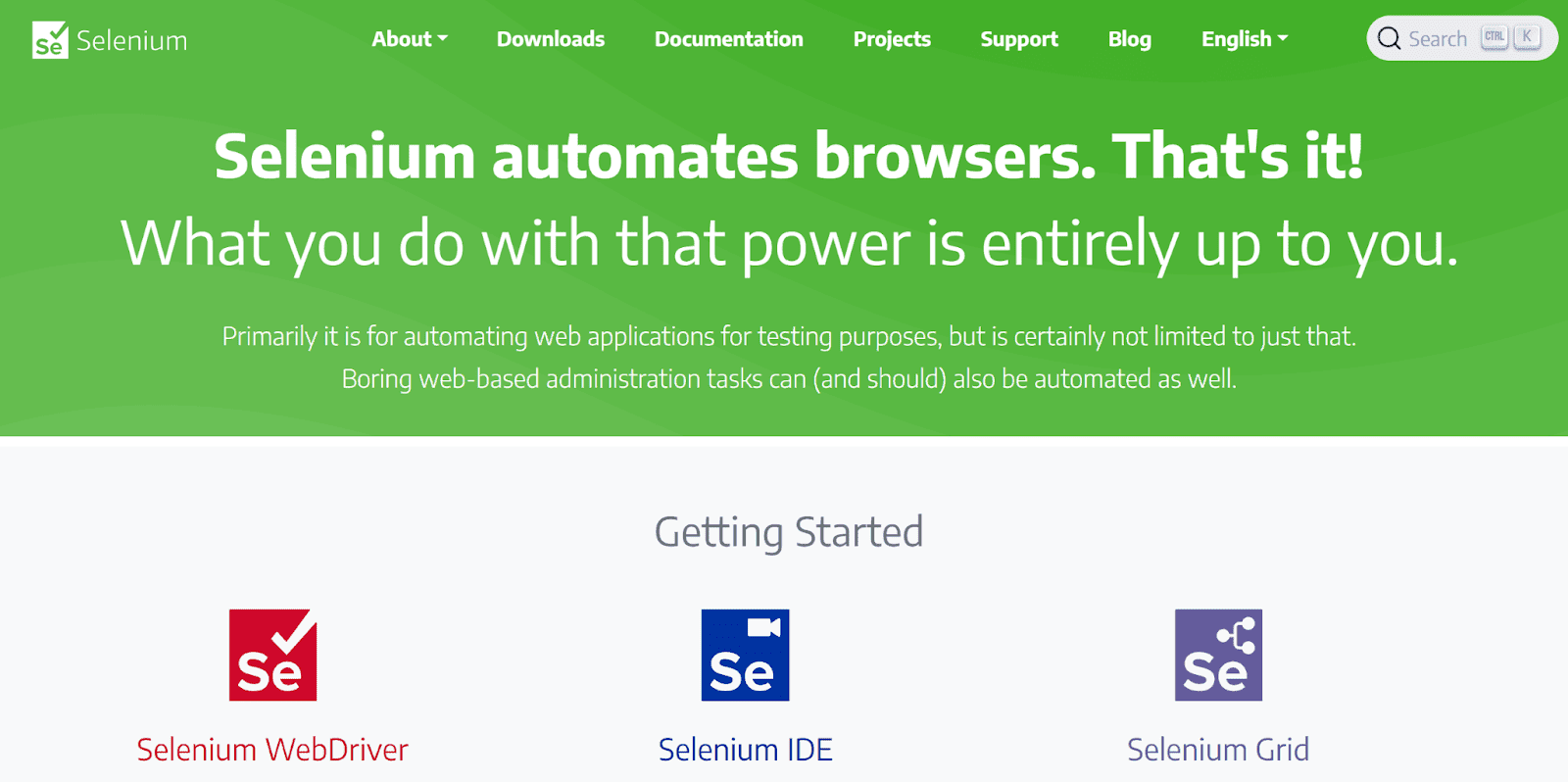
Selenium is an open-source software suite for automating web browsers. It allows developers to write scripts that interact with websites to simulate human behavior, such as clicking buttons, filling out forms, and navigating between pages. Selenium is commonly used for web application testing and supports multiple programming languages, including Python, Java, C#, and Ruby.
Selenium has been around for a while in the automation world. Testers using the Selenium framework can quickly provide test cycles by automating repetitive test cases. Selenium can assist with a reliable, bug-free release deployment workflow when connected with a CI/CD pipeline.
Eye-catching Features of Selenium:
- It supports multiple browsers, including Chrome, Firefox, Safari, Internet Explorer, and Edge.
- It supports multiple programming languages, including Java, Python, C#, Ruby, and others.
- It is easy to integrate with tools like JUnit, TestNG, Maven, Jenkins, and others.
- It supports parallel testing, which means multiple tests can be run simultaneously.
- It provides a feature of recording and playback tests with Selenium IDE.
- It is highly customizable, i.e., plugins and extensions can be added.
- It has a large and active community of users and developers, which makes finding solutions to problems and getting support easier.
Selenium 4 introduces several new features that enhance the capabilities of the Selenium WebDriver for web testing. One of the standout features is relative locators, which provide a more robust way to locate elements on a web page by using the position of other elements as reference points. This approach is beneficial for dealing with dynamic web content where element positions may change.
Another significant enhancement in Selenium 4 is the NetworkInterceptor, which allows you to intercept and modify network requests made by the browser. This feature is crucial for scenarios where you must simulate network conditions or monitor network traffic during testing.
If you want to explore all the features of Selenium 4, comprehensive tutorials cover everything from basic concepts to advanced techniques. These tutorials can help you get up to speed with Selenium 4 and take advantage of its new features for more efficient and effective web testing.
Playwright
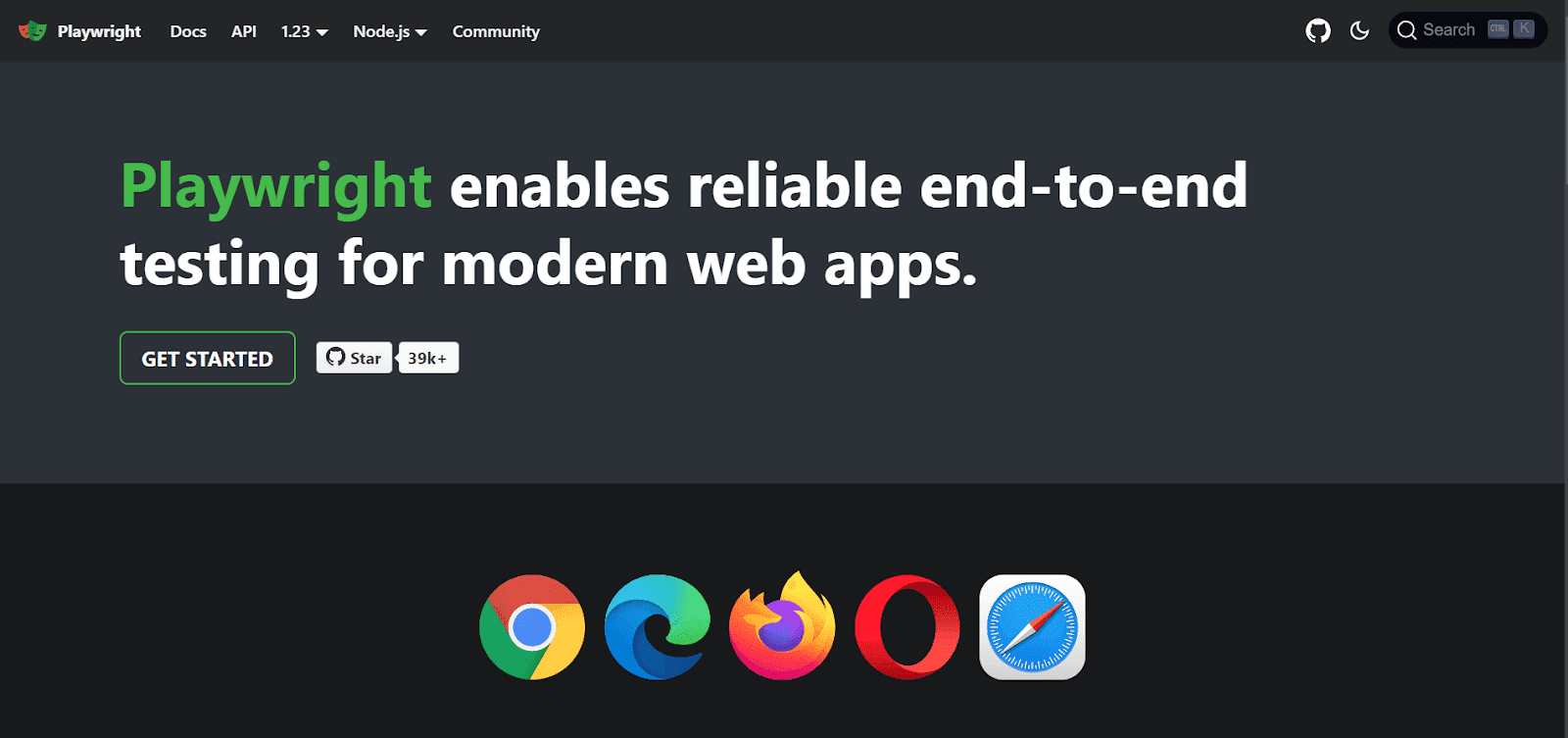
Playwright is a cross-browser automation framework created by the Microsoft team for end-to-end testing and has been steadily gaining popularity. Most users place it at the top of their preferred automation testing frameworks. It uses a Node.js module to automate Chromium, Firefox, and WebKit browsers with a single API. You can conduct Playwright testing with Node.Js, JavaScript, and TypeScript.
Eye-catching Features of Playwright:
- It supports parallel testing on various browsers.
- It supports various selectors and related techniques such as Text selector, CSS selector, XPath selector, React selector, etc.
- It supports modern frameworks like React, Angular, and Vue.
- It supports easy integration with CI/CD tools, and for language bindings, docker images are accessible.
- It comprehends your TypeScript and JavaScript code. No setting is needed for TypeScript language support.
- It offers various debugging options that make it developer-friendly.
To learn more about Playwright, watch the detailed video tutorial below and gain valuable insights.
 Note
NoteRun your test scripts instantly on 3000+ browsers and OS combinations. Try LambdaTest Today!
Cypress
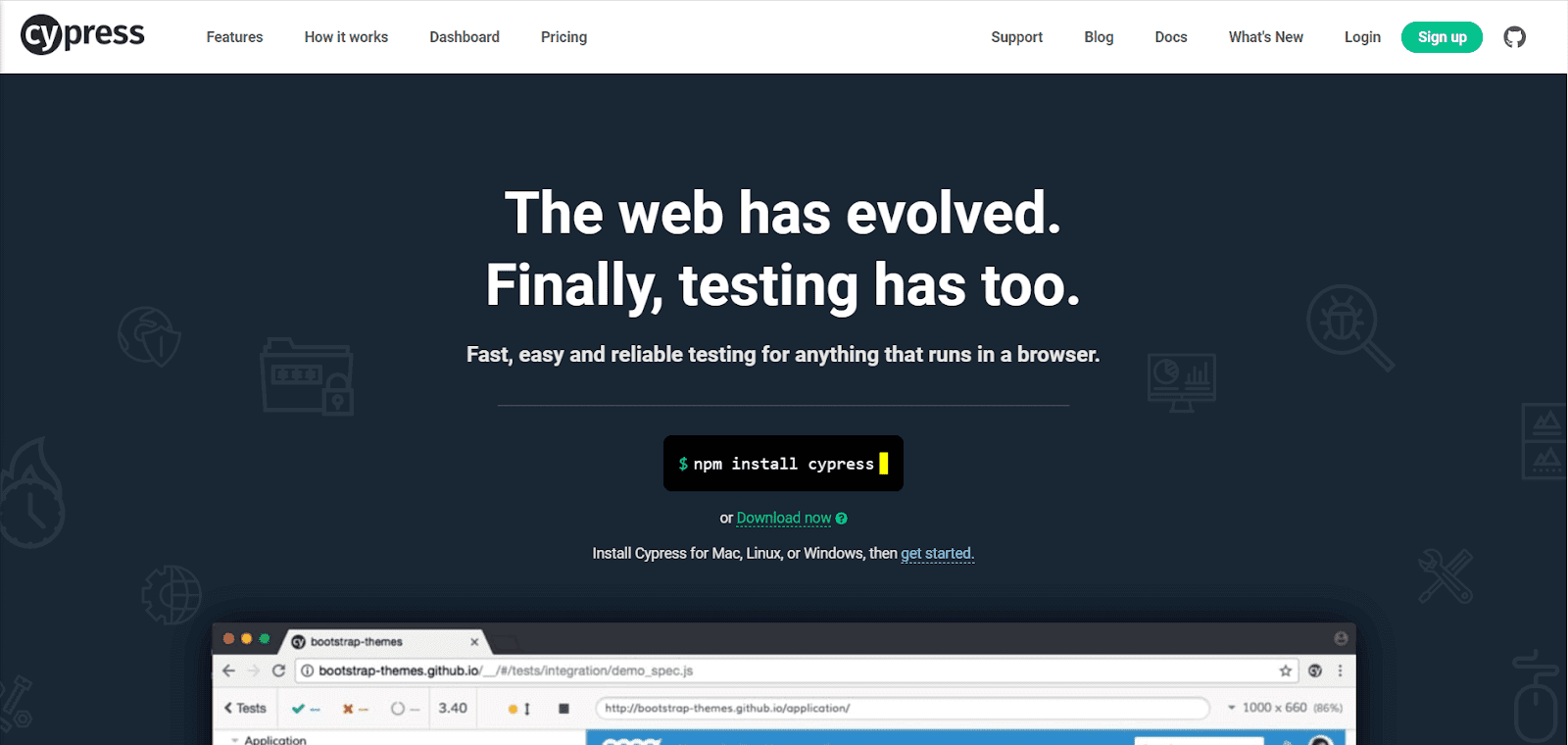
Cypress is an open-source, feature-rich, and simple-to-use end-to-end testing framework for online applications. Cypress is a relatively new participant in automation testing and has recently experienced significant growth. It is an automation testing framework highly favored by the developer community. Applications can be tested quickly, efficiently, and effectively in browser environments.
Eye-catching Features of Cypress:
- It offers speedy, consistent, and reliable test execution results because of its architectural design.
- It provides a clear error message mentioning why the script failed.
- It has access to various elements natively to perform Cypress testing quickly.
- It provides an intuitive API and doesn’t need any initial setting.
- It supports various testing such as end-to-end, integration, component, API, and unit testing.
- It offers a well-organized support doc, i.e., extremely helpful to get started.
- It provides various automation testing tools to make use of while debugging.
To learn more about Cypress in detail, watch the video below. Learn everything you want to know about Cypress and enhance your testing experience.
WebdriverIO
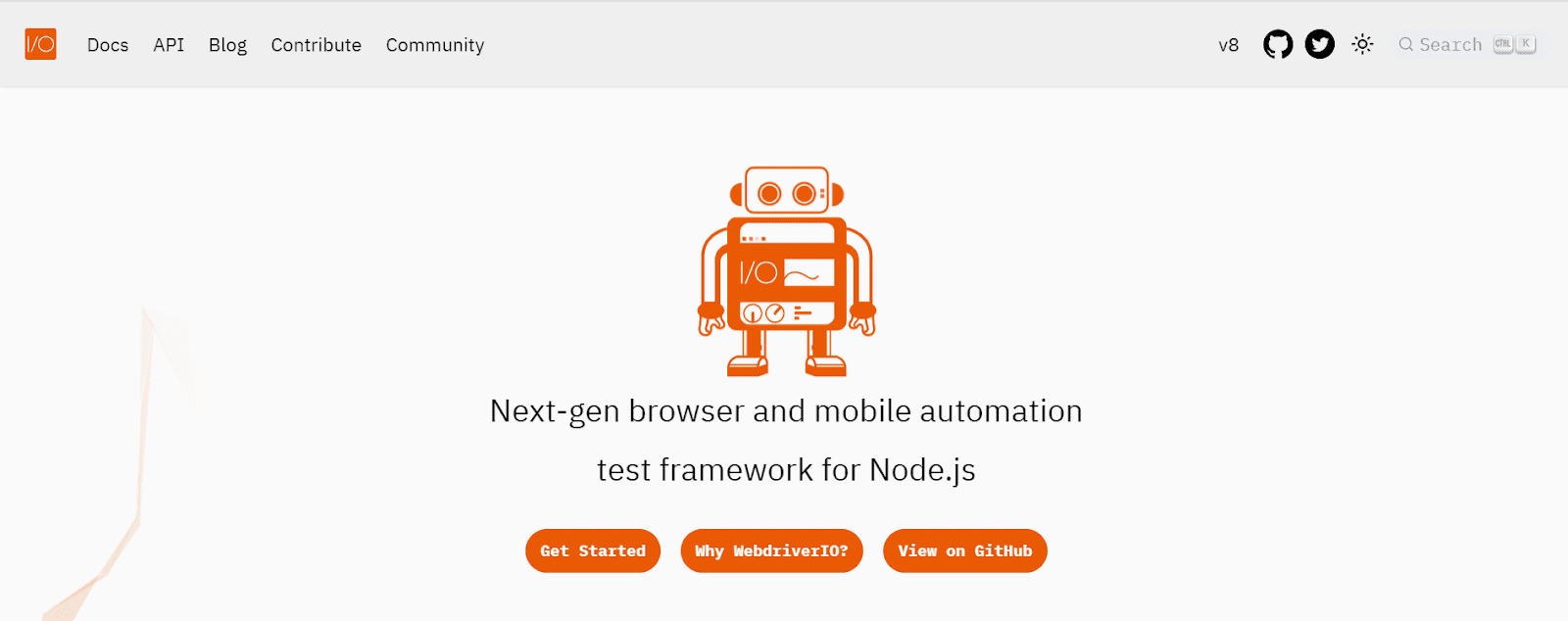
Popular and regarded as one of the most fantastic test automation frameworks, WebdriverIO supports ChromeDev tools and the WebDriver protocol. It is an open-source progressive automation framework built with a Node.js foundation. WebdriverIO can automate any application with modern web frameworks like React, Angular, Polymer, or Vue.js and native mobile apps for Android and iOS.
Eye-catching Features of WebdriverIO:
- It supports all major browsers.
- It is a quick and easy installation.
- It supports page object patterns.
- Its WebDriver Protocol can be used for cross-browser testing.
- Its Chromium-based automation can be utilized with the Chrome DevTools Protocol.
TestCafe
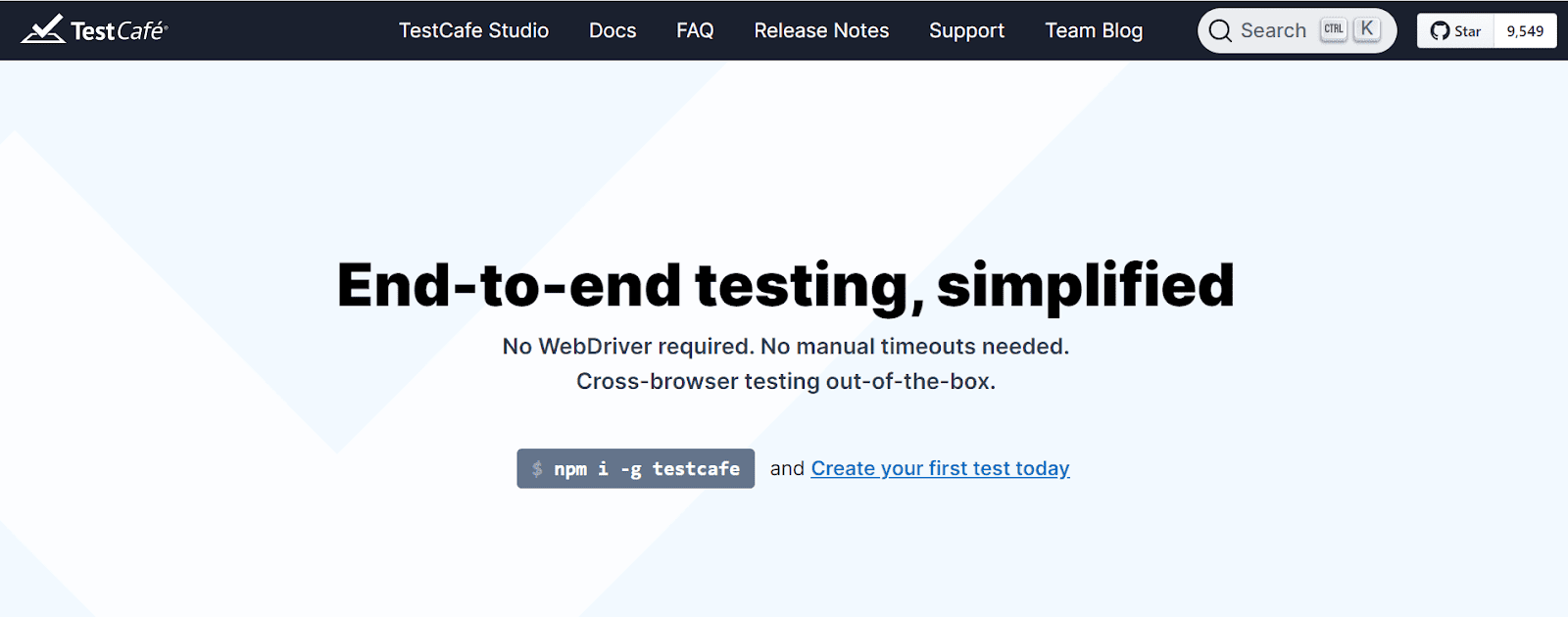
TestCafe is a simplified cross-browser end-to-end testing framework. WebdriverIO or any other testing software is not necessary to use TestCafe. It utilizes your current browsers and is powered by Node.js. TestCafe provides a high-level API for interacting with web applications, making it simple for developers to write tests for everyday tasks such as filling out forms, clicking buttons, and more.
Eye-catching Features of TestCafe:
- It easily integrates with popular CI/CD solutions.
- It allows the execution of the tests in multiple browsers at once.
- It will enable you to insert manual timeouts and use cumbersome boilerplate expressions.
- It offers simple syntax, thus helping in team productivity.
- It provides built-in debug mode.
NightwatchJS
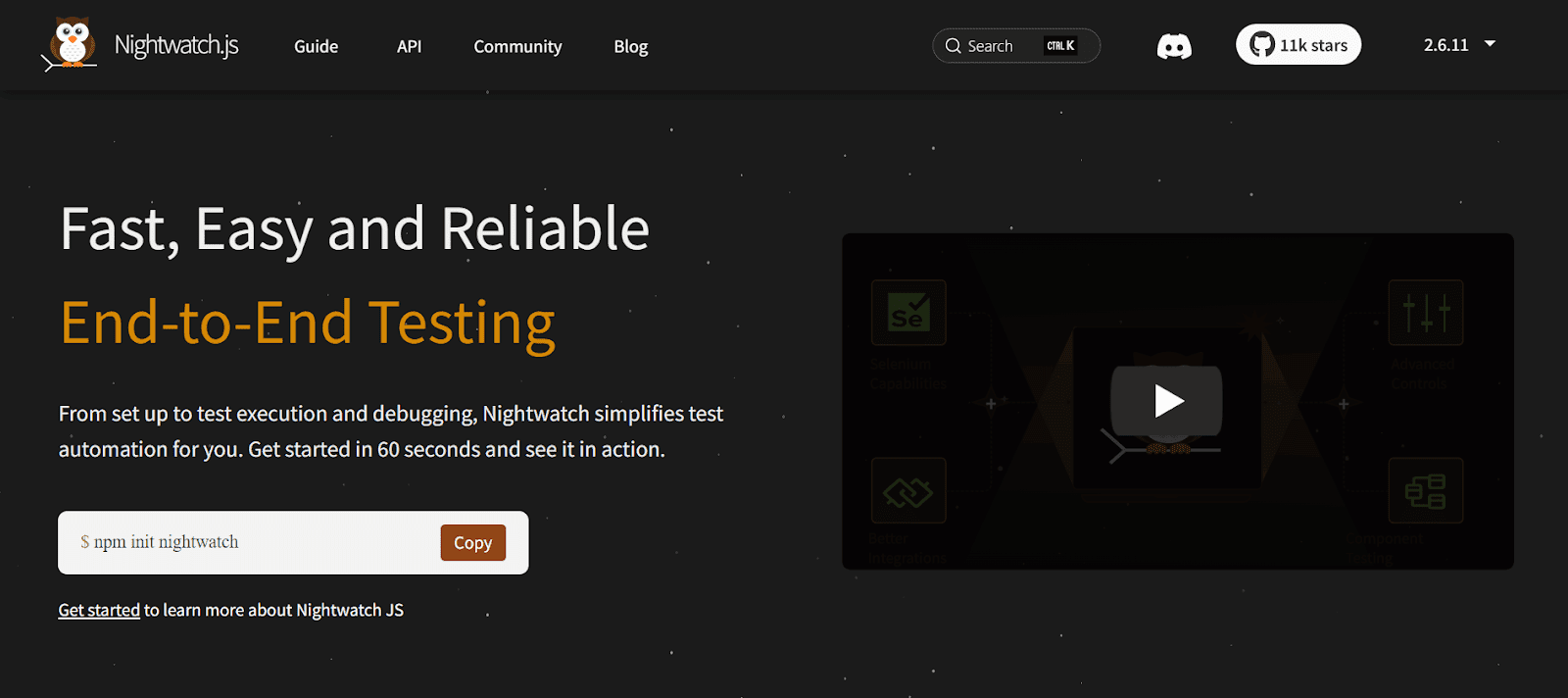
Written in Node.js, Nightwatch.js is an integrated, user-friendly end-to-end testing solution for websites and web applications. To control browsers and issue instructions and assertions on DOM components, it makes use of the W3C WebDriver API. It quickly lays the foundation for continuous integration.
Eye-catching Features of NightwatchJS:
- It allows parallel tests using the built-in command-line test runner, including implicit waits and retries.
- It supports CSS and XPath selectors, and the Page Object Model (POM) is simple.
- It is flexible, allowing you to develop your plugins and expand the built-in commands and assertions APIs.
- It allows straightforward syntax, making it incredibly practical and easy for developers to create tests quickly.
Appium
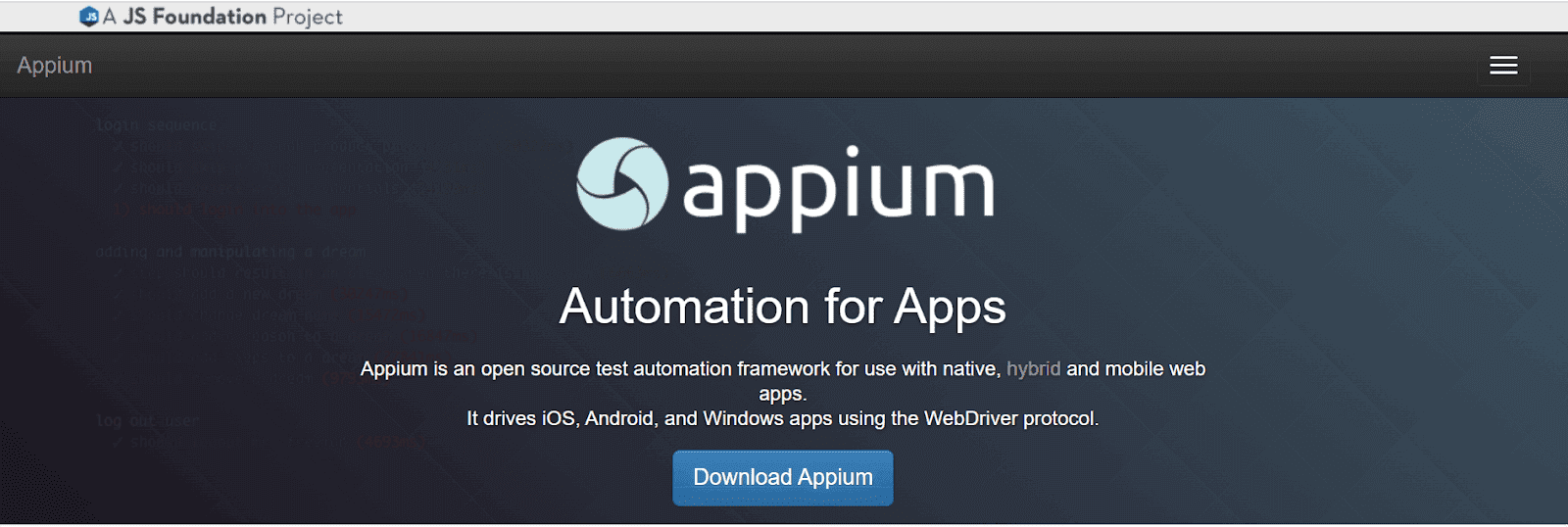
Appium is an open-source automation testing framework for native, mobile, web, and hybrid Android, iOS, and Windows applications. Using the same API enables you to create tests for several platforms. The functional GUI with Appium makes inspecting and writing code easier.
Eye-catching Features of Appium:
- It supports numerous programming languages, including Java, Ruby, C#, PHP, and Python.
- It is supported on all real devices, emulators, and simulators.
- It offers a recording feature that makes it simple for beginners to test mobile applications.
- It requires no server or code changes are necessary, and nothing needs to be installed on the device.
- It is easily integrated with DevOps tools.
Learn how to perform mobile app testing using Appium from the detailed video tutorial given below and get started with your mobile app testing journey.
Espresso
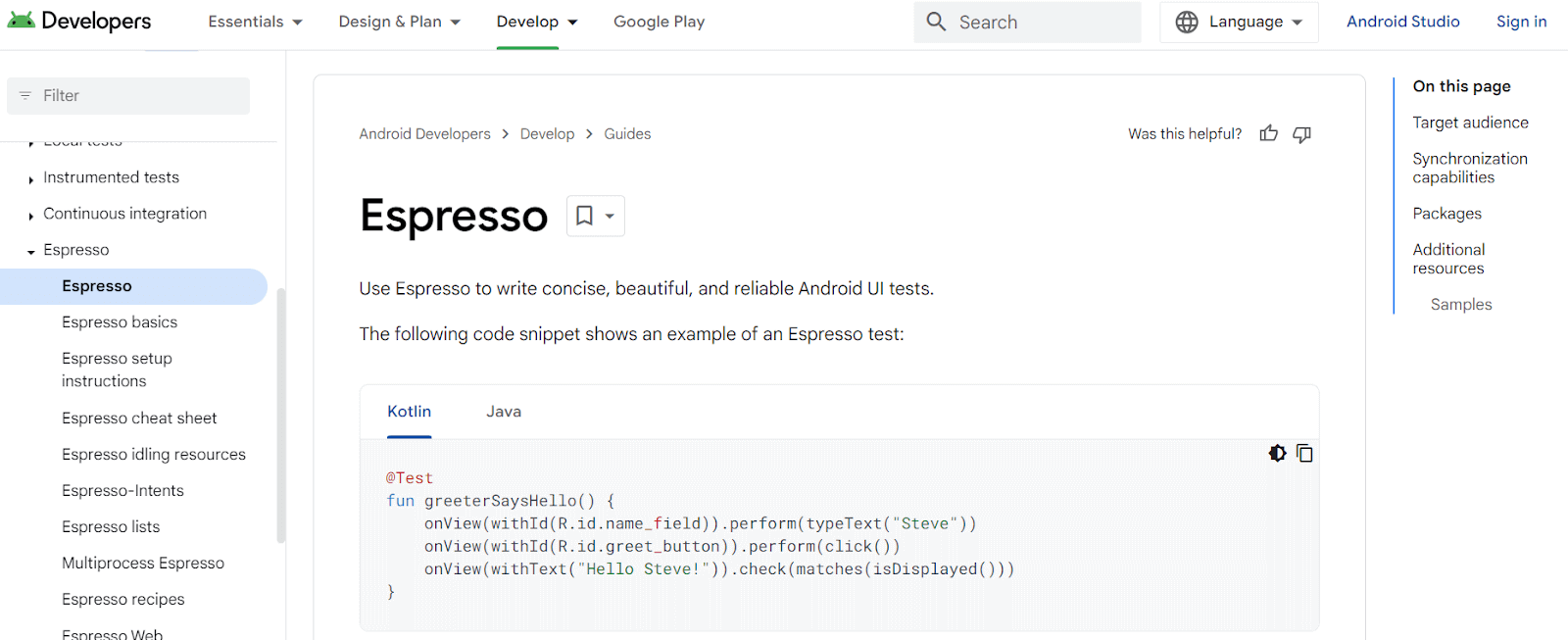
Espresso is a highly recognized automation testing framework for testing Android applications. Developed by Google, it offers a concise and efficient API for automating interactions with UI components of Android apps.
This open-source framework is compatible with real devices and emulators, making it versatile for various testing environments. It is praised for its fast and reliable test execution, contributing to its popularity among developers and testers.
Eye-catching Features of Espresso:
- It supports Java and JUnit for native applications, enabling developers to write tests in familiar languages.
- It offers lightweight APIs that simplify the maintenance of test code.
- It automatically synchronizes UI elements and testing actions, ensuring reliable test execution.
- It can compile Android UI tests to APKs for easy distribution and deployment.
- It is commonly used for unit and black-box testing, providing comprehensive testing capabilities for Android apps.
XCUITest
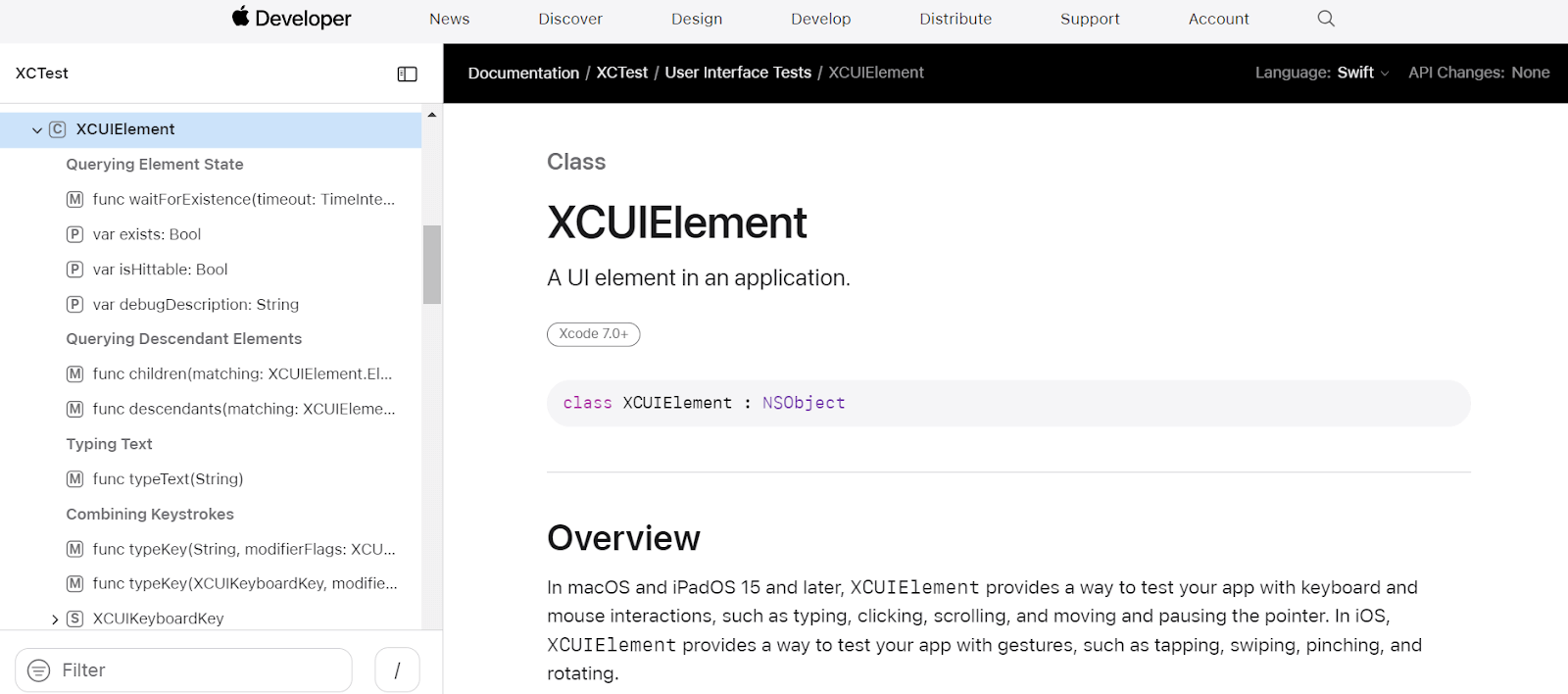
XCUITest is an automation testing framework designed specifically for iOS app testing. One of its key features is its ability to test native and hybrid iOS applications. It allows developers to write tests in Swift, Apple’s programming language, providing seamless integration with Xcode, Apple’s integrated development environment (IDE).
It also supports parallel testing, enabling developers to run multiple tests simultaneously on different devices. This feature helps in saving time and resources during the testing process.
Eye-catching Features of XCUITest:
- It seamlessly integrates with Xcode, third-party tools, and frameworks for recording tests.
- It simplifies coding through methods, subclasses, and assertions.
- It supports continuous integration and deployment (CI/CD) integration.
- It is well-suited for black-box testing, ensuring comprehensive app testing capabilities.
Robot Framework
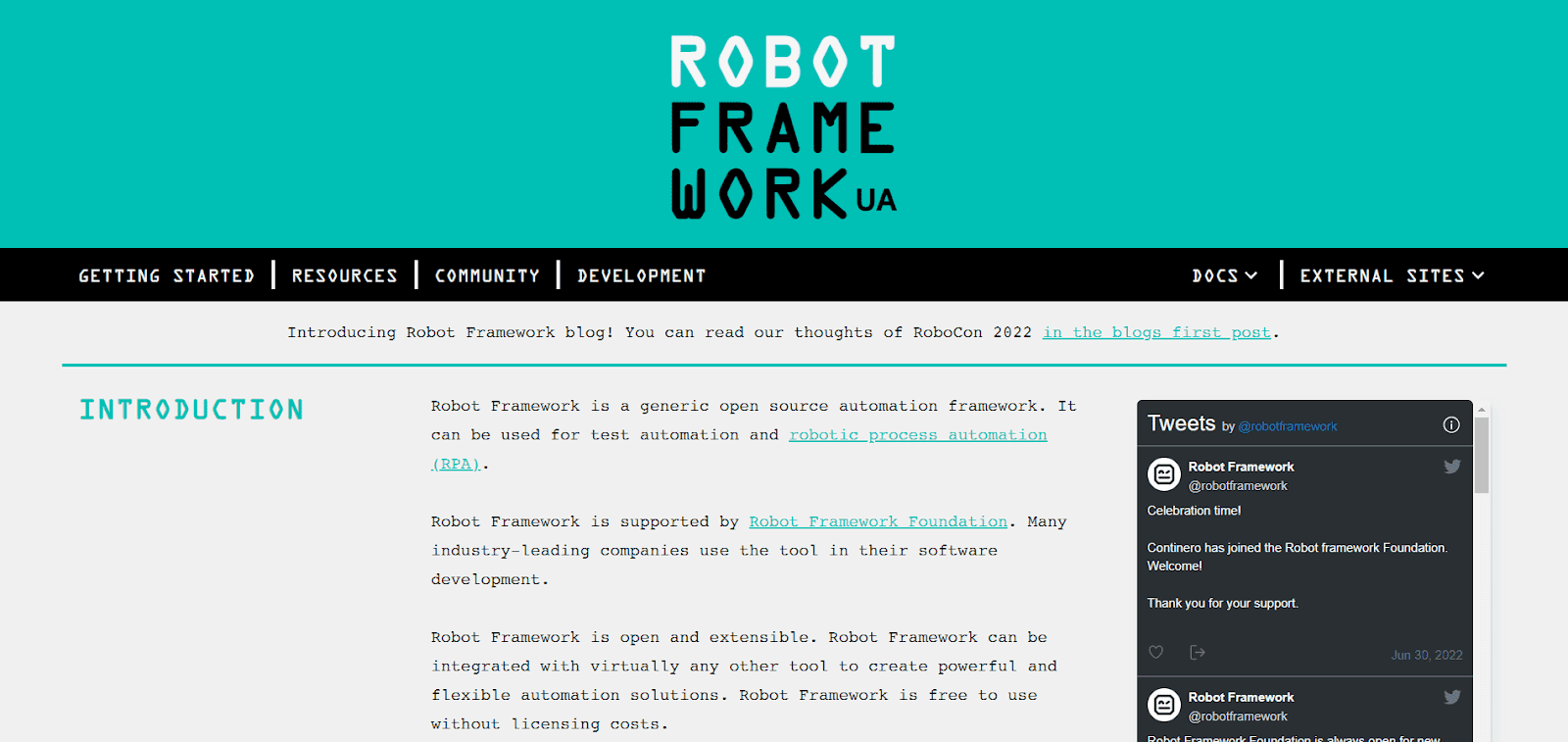
Robot is an open-source automation testing framework for acceptance testing and acceptance test-driven development. It adheres to several test case formats. Robot framework provides good support for external libraries and open-source tools that can be used for automation. Any platform, program, browser, or technological advancement can use a Robot framework. With this, you may create test scripts for several systems. If you are familiar with keyword-based testing, learning this is simple.
Eye-catching Features of Robot:
- It offers predefined test cases or user-defined keywords in a tabular format.
- It allows users to choose to create their own keywords.
- It offers various variables to use.
- It provides smooth communication between libraries and tools.
- It enables labeling proper test cases when performing smoke, regression, system, etc. tests.
Watch the video tutorial below, get started with Robot Framework, and enhance your automation skills.
Cucumber
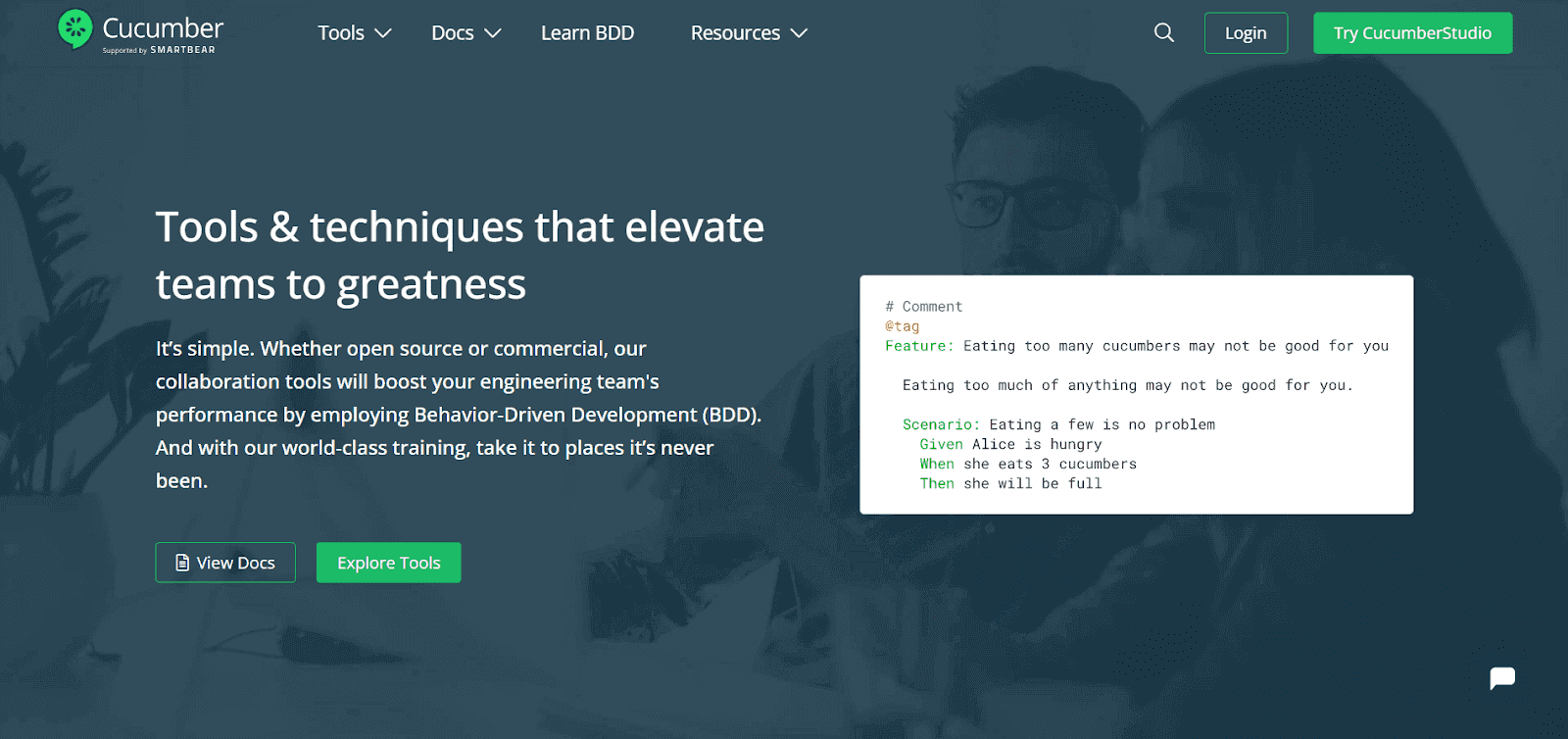
Cucumber is an open-source automation testing framework that uses a Behaviour-Driven Development methodology for automating tests. It incorporates test plans and documentation. It was first programmed in Ruby, but a separate Gherkin script was later introduced. Cucumber provides a high-level API for automating tests, and it supports a wide range of programming languages, including Java, Ruby, and JavaScript.
Eye-catching Features of Cucumber:
- It bridges the gap between business and technical language.
- It helps you write test scripts without programming experience.
- It supports your testing framework from beginning to end.
- It uses a streamlined test script design that allows for code reuse.
Puppeteer
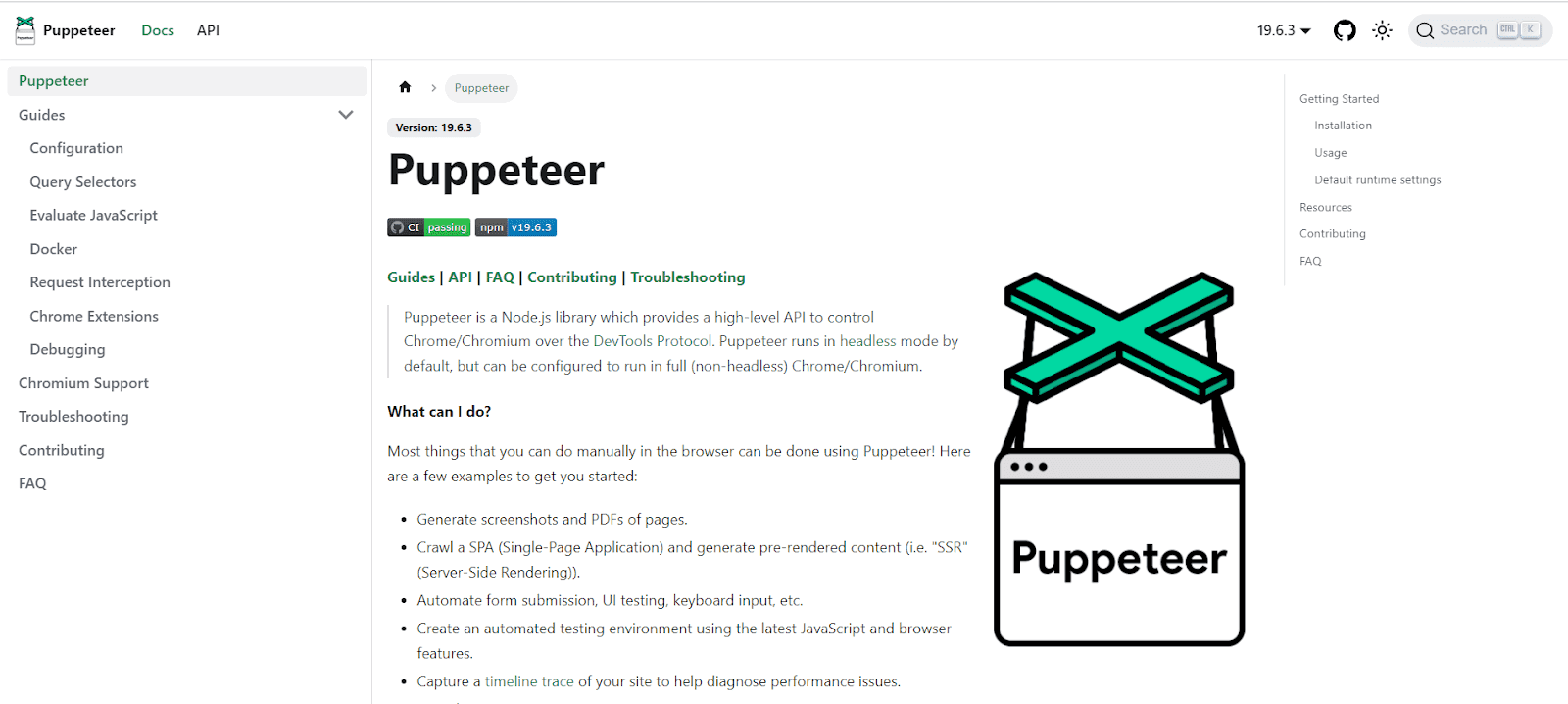
Puppeteer is an open-source automation testing framework that uses a Node.js library developed by Google that provides a high-level API for controlling headless Chrome or Chromium browsers. It allows developers to automate, test, and scrape web pages by mimicking user interactions like clicking, typing, and scrolling.
It also provides access to the DevTools protocol, enabling developers to generate screenshots, crawl websites, and automated form submissions. It is suitable for automating and testing web applications, as well as for web scraping and data extraction.
Eye-catching Features of Puppeteer:
- It tests screenshots and saves PDF versions of the pages.
- It utilizes the Chrome performance analysis tool to measure load time.
- It automates keyboard input, form submission, UI testing, etc.
Gauge
Gauge is an open-source automation testing framework primarily utilized for acceptance testing. It tests consist of two files: the specification file, which resembles the Cucumber feature file but has a different syntax, and the implementation file, which resembles the Cucumber definition file.
It is compatible with C#, Java, JavaScript, Ruby, and more languages. It facilitates conducting parallel tests and is simple to integrate with DevOps tools. However, the Gauge needs more community support because there are fewer users.
Eye-catching Features of Gauge:
- It offers tools and languages of your choice.
- It provides a robust ecosystem and plugin architecture.
- It allows you to take screenshots when the test fails or anything goes wrong.
- It spends less time setting up time-consuming parallel testing on your CI/CD pipelines.
- It supports test-driven data.
JUnit
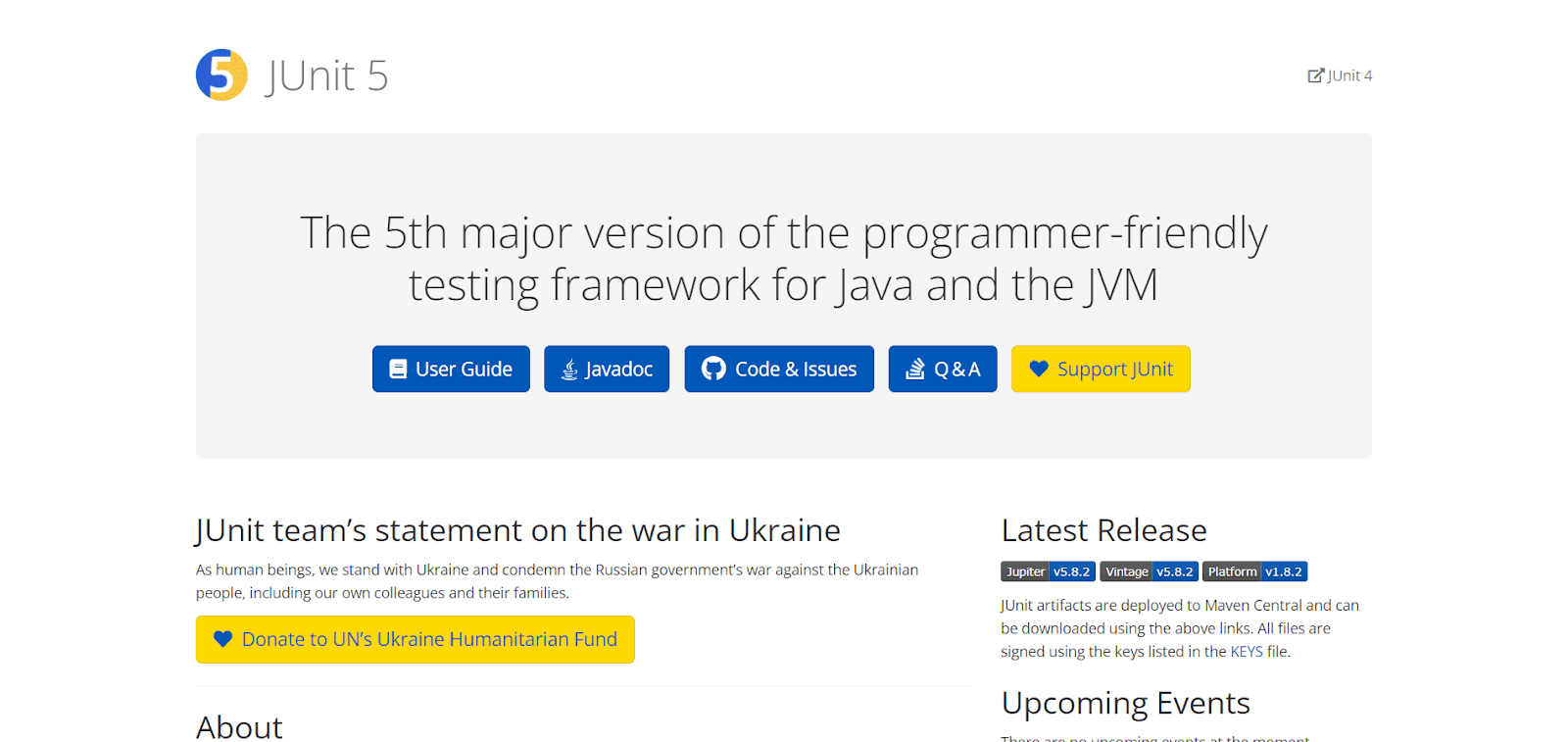
JUnit automation testing framework has grown significantly in popularity due to Java’s widespread use in software applications. It distinguishes itself from other testing frameworks by offering a GUI for writing repeatable and manageable test cases. It offers a unique technique for creating more organized, concise, practical test cases. JUnit uses annotations to enable the development of several test scripts for varied needs.
Eye-catching Features of JUnit:
- It annotates test methods with relevant information.
- It provides assertions to test for predicted outcomes.
- It offers test runners for executing tests.
- It develops better and faster codes.
Watch this video to learn how to use the JUnit testing framework. It will help you understand JUnit and how to utilize it to make your testing more efficient.
TestNG
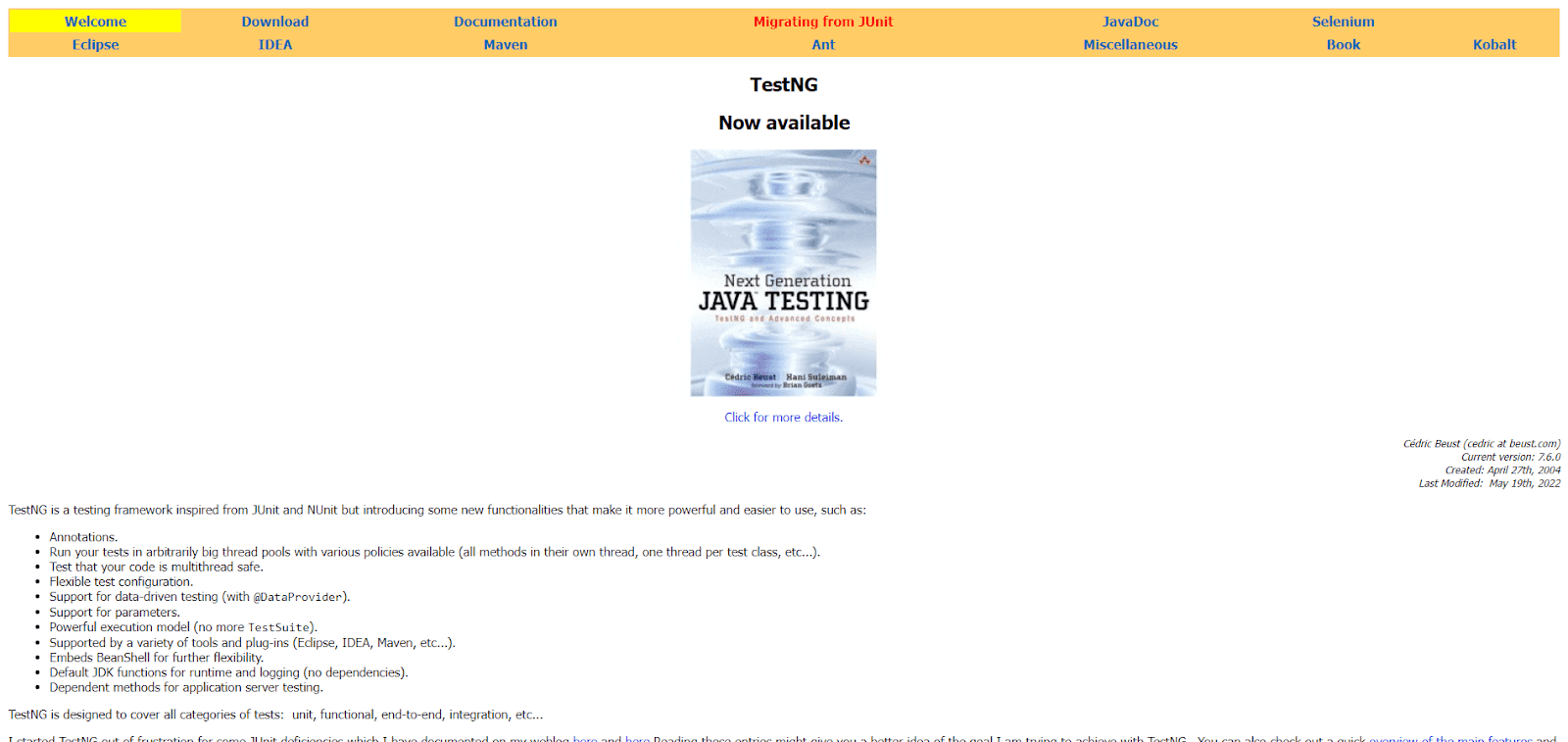
TestNG is an automation testing framework, where NG stands for “Next Generation.” JUnit’s drawbacks are overcome by TestNG, which is meant to simplify end-to-end testing. The number of test cases passed, failed, and skipped can be determined using TestNG and generated in an appropriate report. The failed test cases can be run independently.
Eye-catching Features of TestNG:
- It enables annotations.
- It offers various Java and OOP features.
- It encourages the testing of integrated classes.
- It separates run-time configuration and data information from compile-time test code.
- Its runtime configuration is flexible.
Watch this video to learn more about the TestNG testing framework and boost your testing strategy.
Selenide
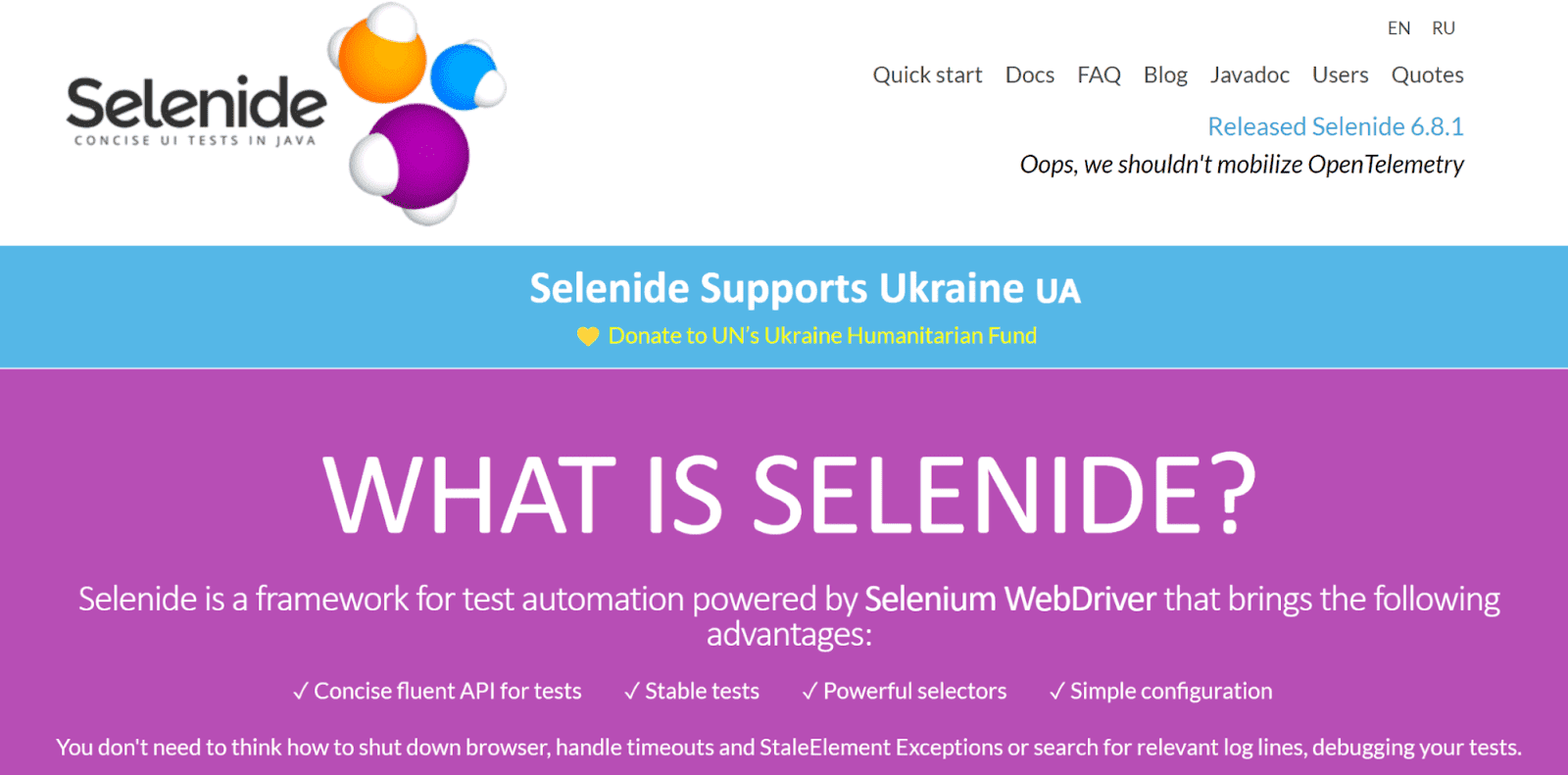
Selenide is a Java-based test automation framework for UI testing. It is built on top of Selenium WebDriver, enabling you to utilize its low-level features while receiving additional features and functions from Selenide. Unlike Selenium WebDriver, Selenide was created primarily for automated testing.
Eye-catching Features of Selenide:
- It avoids pointless coding and maintenance and helps save a massive amount of time.
- It has clear and fluent APIs for tests.
- It has powerful selectors.
- Configuring and enabling easy configuration is simple when setting up this framework.
NodeJS

Built on Google Chrome’s JavaScript V8 Engine, Node.js is a highly robust JavaScript-based platform. It creates I/O-intensive web applications like single-page programs and streaming video websites. Thousands of developers use Node.js for its open source. Networking and server-side apps are developed using Node.js, a cross-platform environment, and a library for JavaScript applications.
Eye-catching Features of NodeJS:
- It is highly scalable, as the event mechanism enables the server to reply non-blocking.
- It reduces the processing time required to upload audio and video files.
- It offers an open-source community with top-notch modules for applications.
Jest
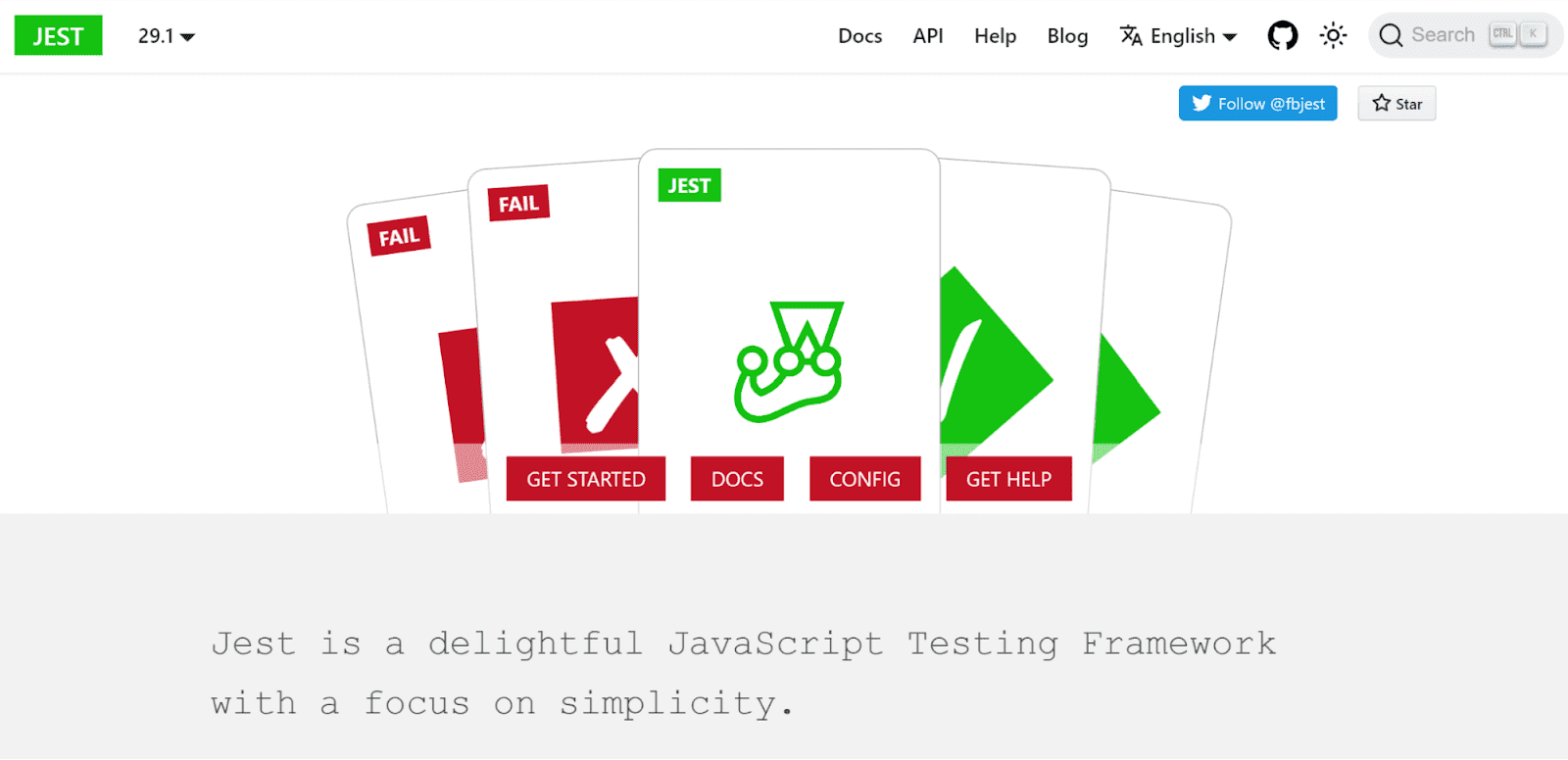
Jest, a JavaScript-based open-source automation testing framework, is primarily made for testing React-based apps. Still, it can be used to create automation scenarios for other codebases that use JavaScript. It is a crucial component of automated browser testing. When compared to other testing frameworks now in use, It is one of the most well-known. Additionally, it offers a hybrid package that combines a test runner, an assertion library, and a built-in mocking library. Mocking is a technique used to replace a natural component of a software system with a simplified version.
Eye-catching Features of Jest:
- It reduces the time to run the test.
- It supports code coverage at an extensive level.
- Its independent tests enable no two Jest tests to interact or impact one another as they run in their sandbox.
- It makes mocking easy for all developers and test engineers.
Mocha
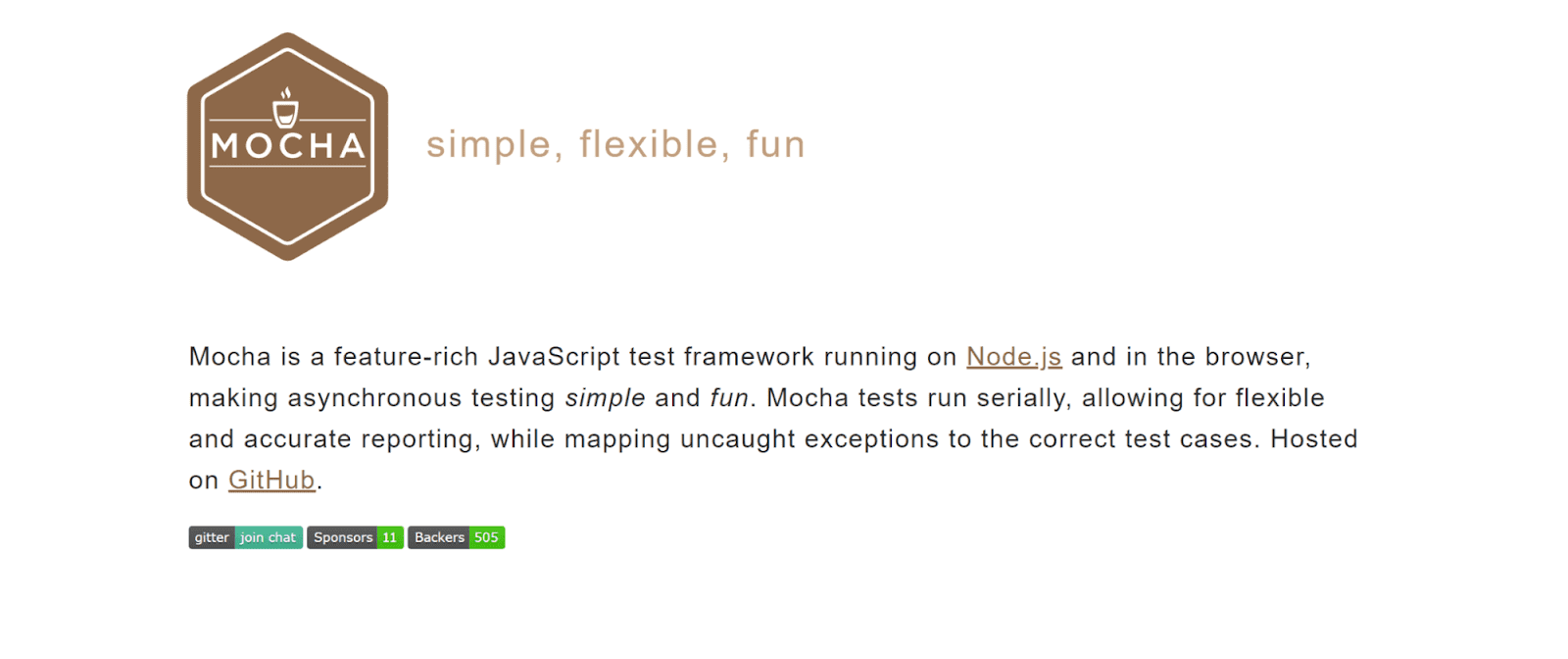
Mocha is a feature-rich, JavaScript-based test automation framework providing support for asynchronous testing, test reporting, and test coverage analysis, among other features, with ease. It runs on Node.js and in the browser. Mocha tests are parallelly executed, allowing for accurate and customizable reporting while assigning the appropriate test cases to uncaught exceptions.
Eye-catching Features of Mocha:
- It allows you to execute test cases directly in the web browser.
- It provides a flawless experience across all major web browsers.
- Depending on their needs, it allows users to choose various reporting alternatives, including the list reporter, the progress reporter, and the JSON reporter.
- asynchronous testing is strengthened by Mocha’s capabilities, which call the callback once the test is complete. By leaving out the callback, synchronous testing is made possible.
Learn how to perform unit testing using Mocha by following this complete guide on Mocha unit testing. This guide will give you valuable insights with practical examples.
Jasmine

One of the top open-source automation testing frameworks for JavaScript is called Jasmine. If you don’t want it to interfere with the IDE or an application, you can run it on any platform that supports JavaScript. Additionally, it has an easy-to-read syntax. Its predecessors, which include various unit testing frameworks like JSpec, JSSpec, RSpec, and ScrewUnit, influenced its capabilities. Support for asynchronous testing and using “spies” to build test duplicates are its main advantages.
Eye-catching Features of Jasmine:
- It provides front-end testing using Jasmine-jQuery.
- Its syntax is straightforward to read.
- It accesses a comprehensive built-in matchers set.
Laravel
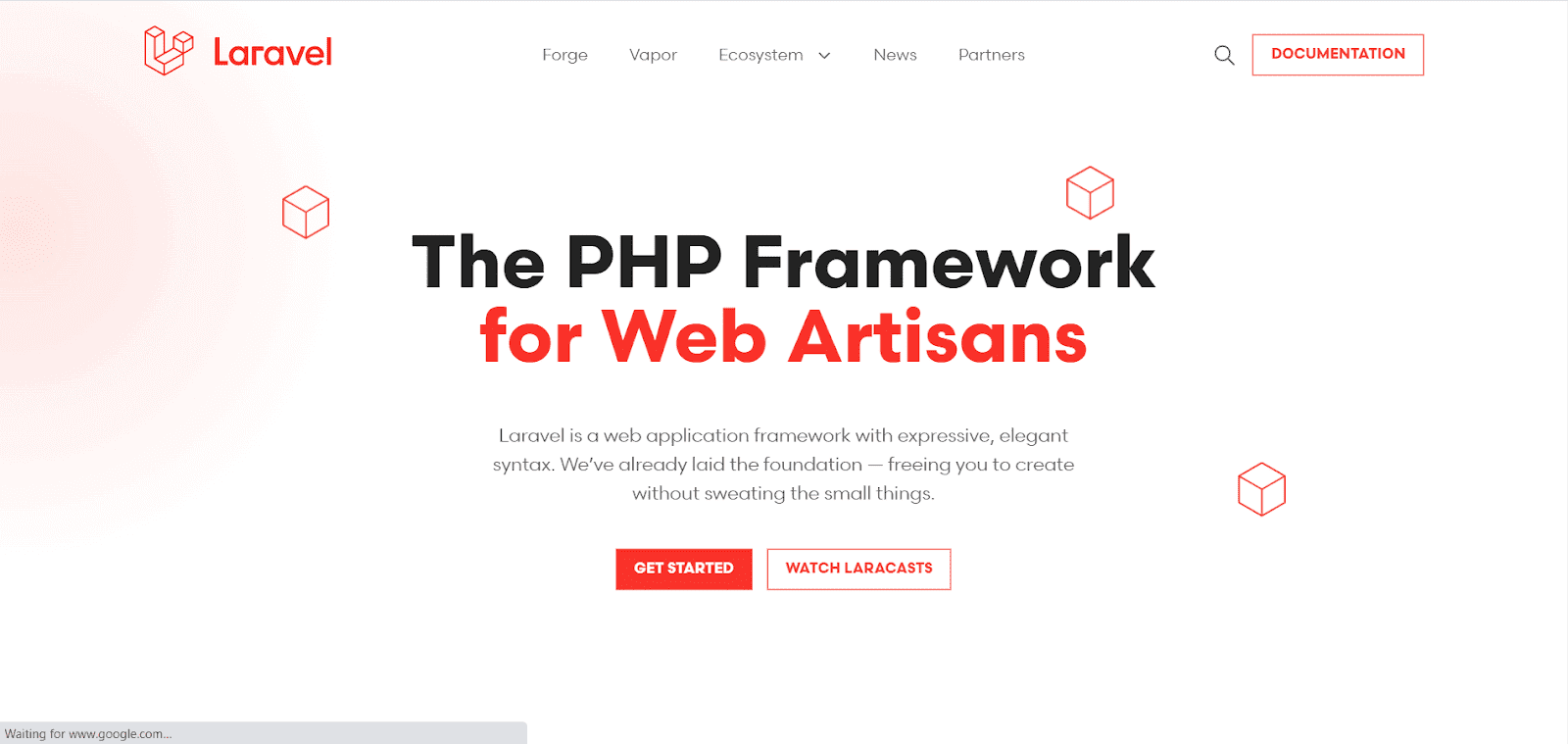
Laravel is a web app automation testing framework with an expressive syntax. Laravel testing encourages concise syntax and clean code. It can be used with just one command, including expressive code, rapid error handling, traffic control, etc. It is noteworthy for developers.
Eye-catching Features of Laravel:
- It utilizes the pre-defined phpunit.xml file setup to get PHPUnit testing functionality.
- It reduces security concerns, including cross-site scripting, SQL injection, and cross-site request forgery.
pytest
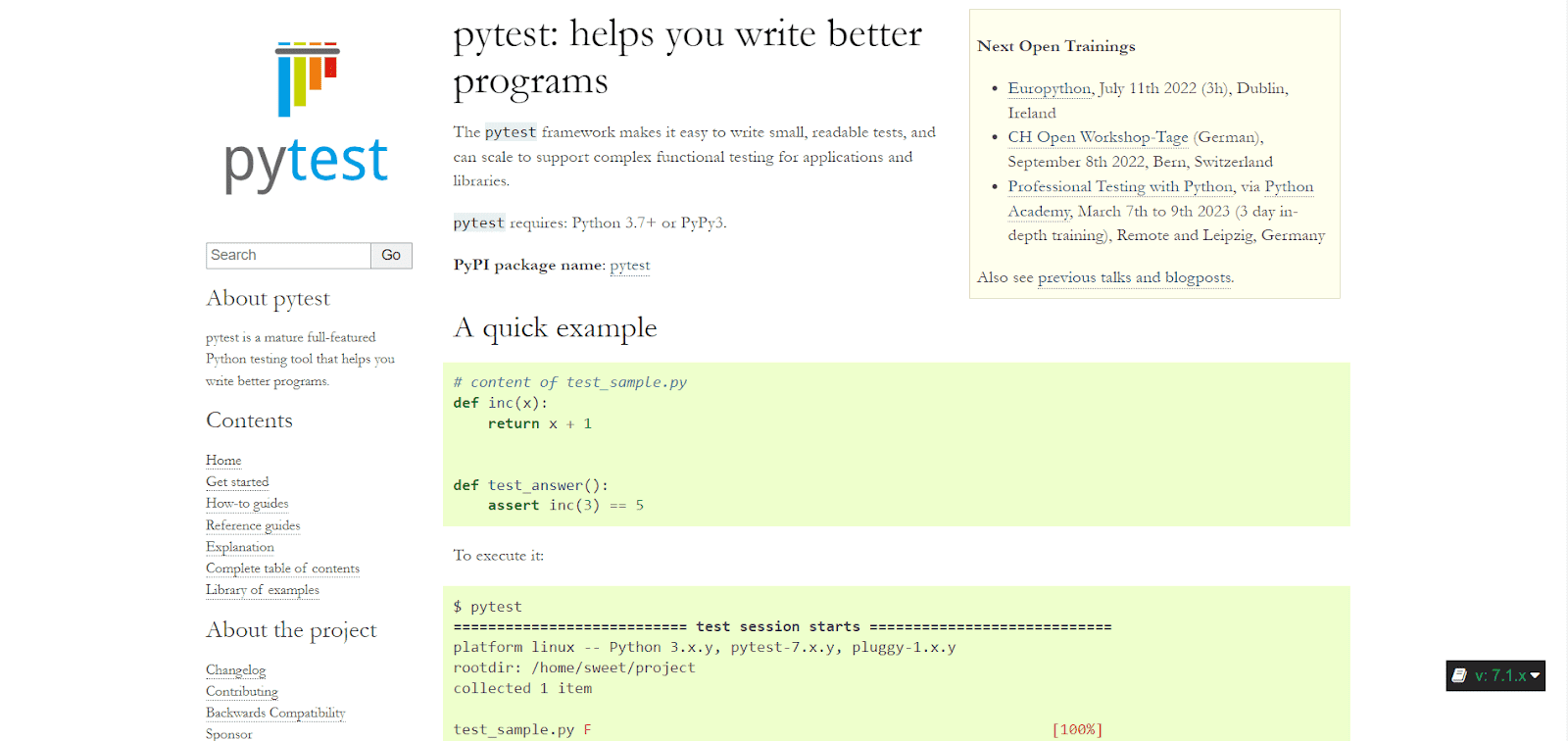
One of the most excellent automation testing frameworks is pytest, which enables you to create test cases using Python programming. It allows you to write simple test cases that are easy to scale and depend on APIs, databases, or user interfaces. You may create any type of test using pytest, from straightforward units to functional tests.
Eye-catching Features of pytest:
- It is simple for beginners because of its more concise syntax.
- It runs tests in parallel with ease.
- It runs a particular test or even a selection of tests.
- It is faster and automatically detects testing.
- It avoids unnecessary tests and concentrates on what is required.
To learn more about pytest, watch this video tutorial. It covers everything from basics to advanced topics, helping you write your first test using pytest and gain valuable insights.
Subscribe to the LambdaTest YouTube channel for detailed guidance and tutorials on real device cloud, mobile app testing, Appium testing, and more.
Taiko
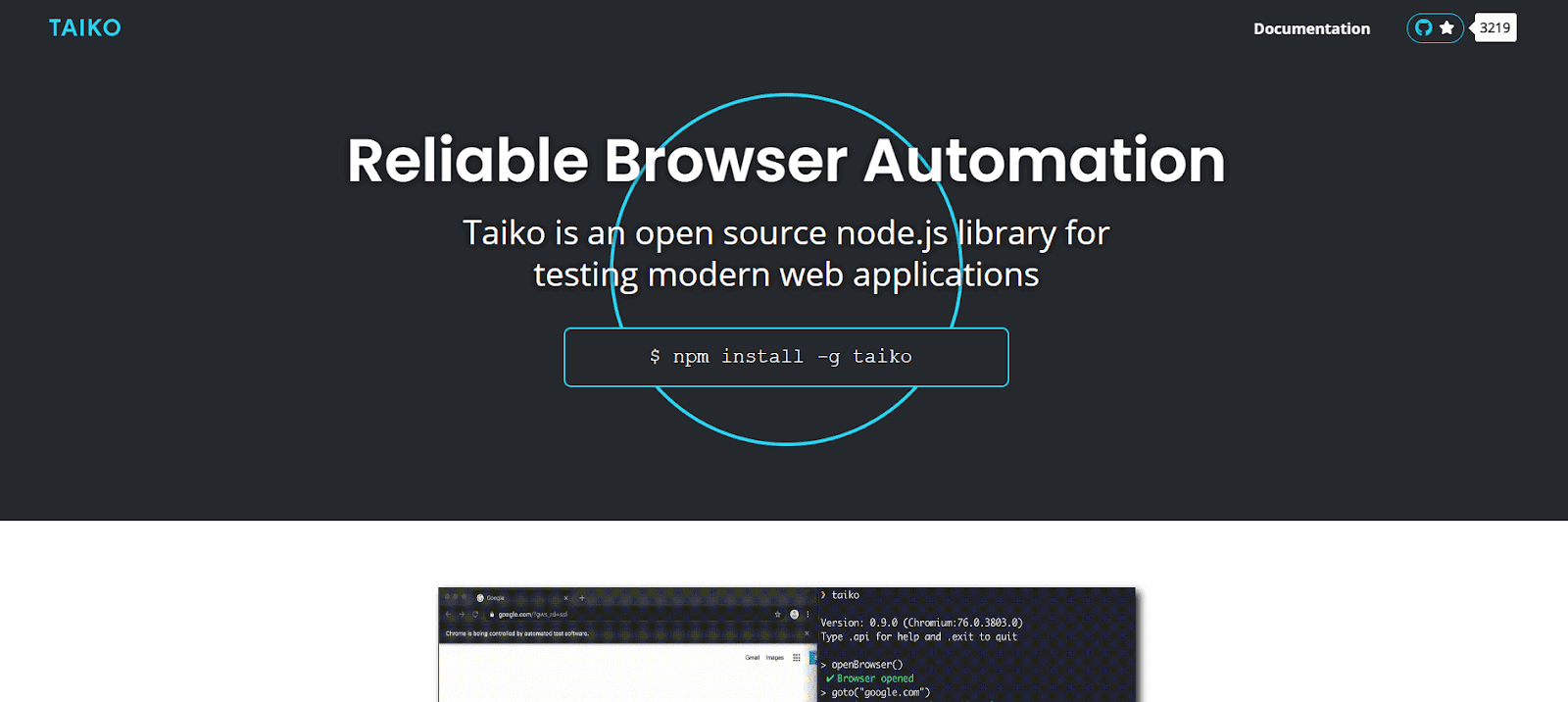
Taiko is an open-source automation testing framework created by Thoughtworks. It uses the Node.js module to automate the Chrome browser. Taiko allows you to create more readable and maintainable JavaScript tests. You can use a plugin to run Taiko tests on the LambdaTest platform if you search for a more straightforward and scalable solution.
Eye-catching Features of Taiko:
- It gets accurate results by eliminating incorrect tests.
- Its Installation only takes a few minutes.
- It offers the advantage of an interactive recorder to catch the bugs.
- It controls dynamic content and XHR.
- It is compatible with Windows, macOS, and Linux.
NUnit
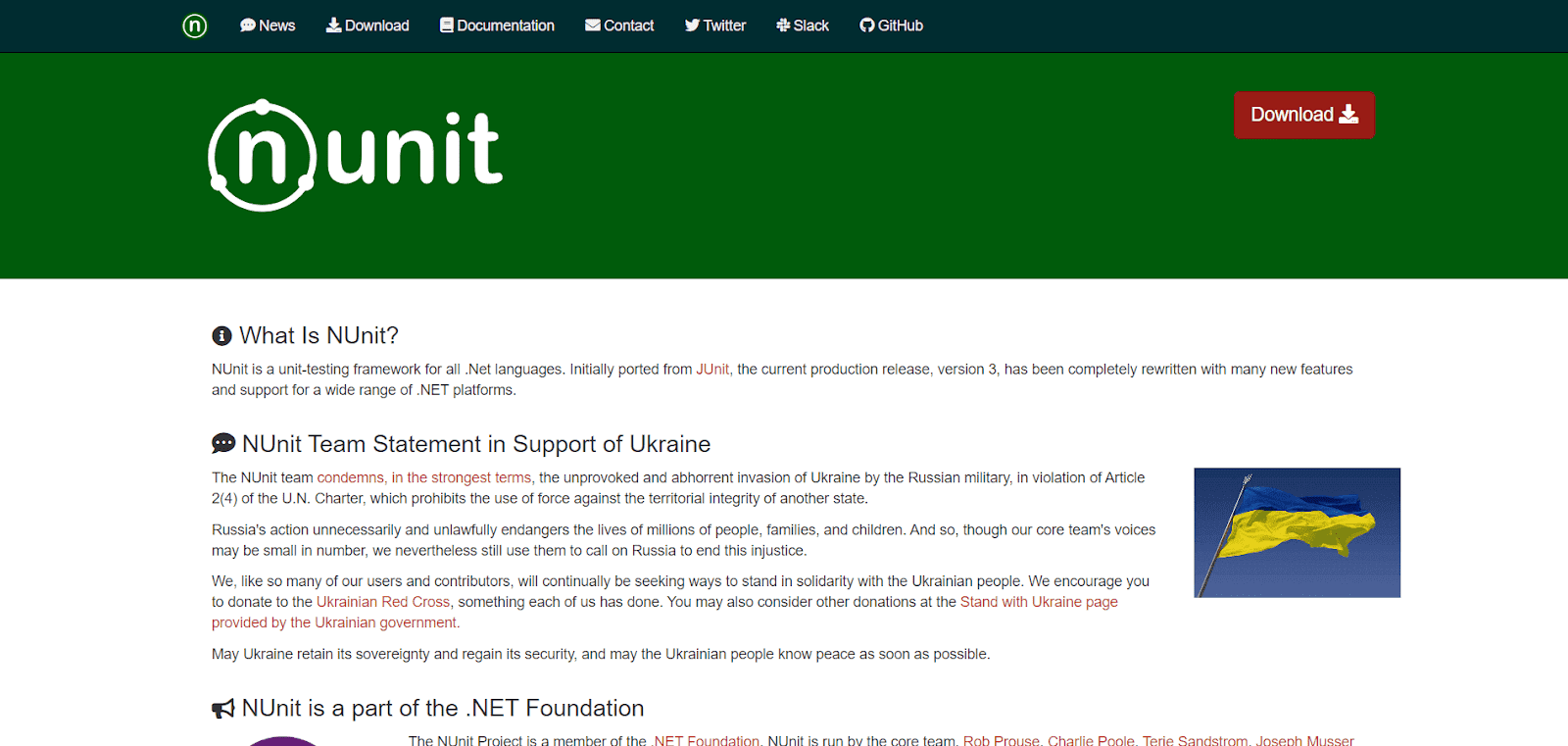
One of the top unit testing frameworks for the .NET language is NUnit. The most recent version, completely redesigned with several new features and support for .NET platforms, was initially migrated from JUnit. The component or base for the test runner is the NUnit Engine.
Eye-catching Features of NUnit:
- Its engine allows running tests against NUnit 3. X and many frameworks.
- It allows effective communication between test writers and NUnit Engine.
- It allows running NUnit 3 tests in Visual Studio using its similar test adapter.
To get started with the NUnit testing framework for Selenium automation testing, watch this video. It will teach you about NUnit and how to use it effectively for your testing needs.
Codeception
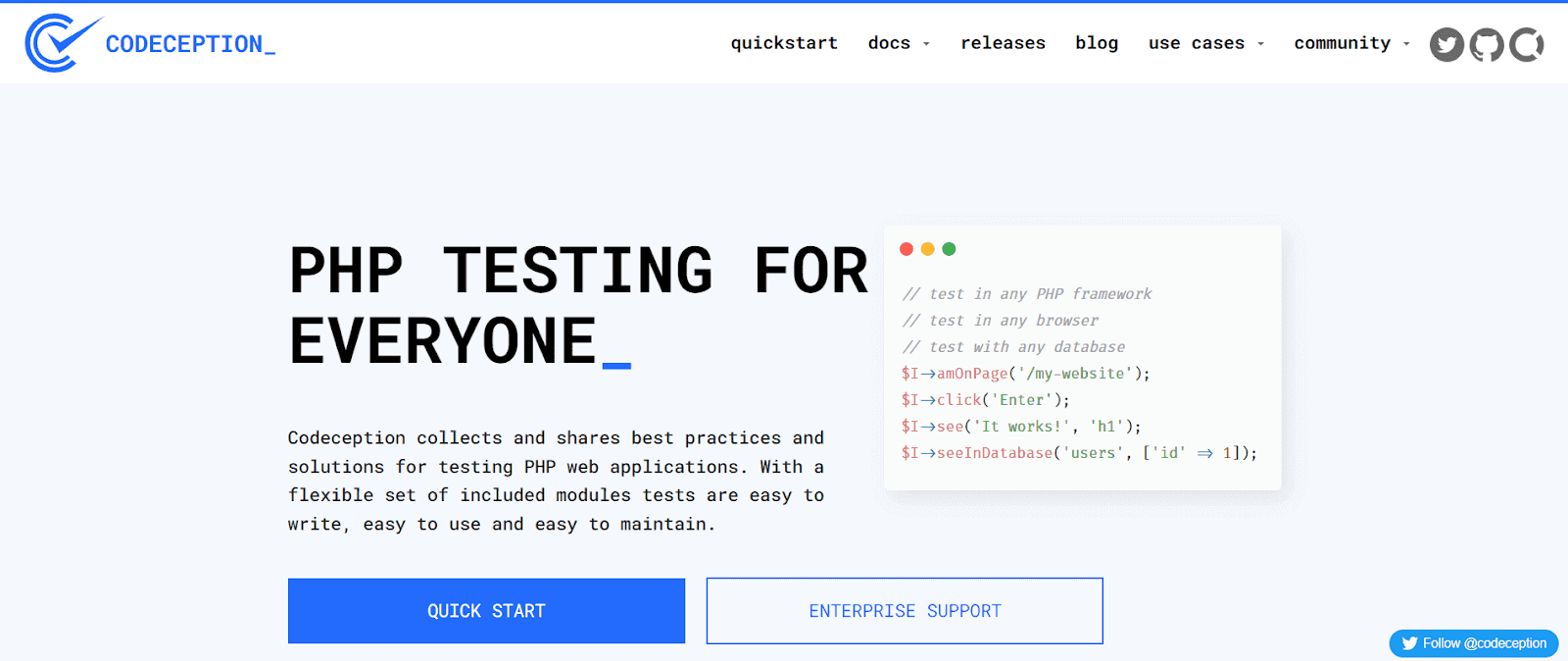
Codeception is another best automation testing framework that gathers and shares best practices and solutions for PHP-built web applications. It introduces a fresh approach to testing by allowing developers to write unit, functional, integration, and acceptance tests in a cohesive, descriptive style inspired by Behavior-Driven Development (BDD).
Despite being PHP-based, users only need basic knowledge to use it efficiently. This is made possible through its collection of custom commands, which streamline the testing process and reduce complexity.
It supports over 20 modules, including Selenium, Laravel, Symfony, Yii, Phalcon, Joomla, and more. These modules define the available actions for writing tests, facilitating seamless integration with various PHP libraries. This approach minimizes the need for additional plugins or extensive customizations, making Codeception a user-friendly choice for testing PHP applications.
Eye-catching Features of Codeception:
- It offers high-level domain language, i.e., a specific set of user actions are used to represent tests.
- It enables web applications to run faster and access internals without needing a web server.
- It makes testing easy for REST and SOAP.
- It offers flexible commands to evaluate the content and structure of JSON and XML files.
PHPUnit
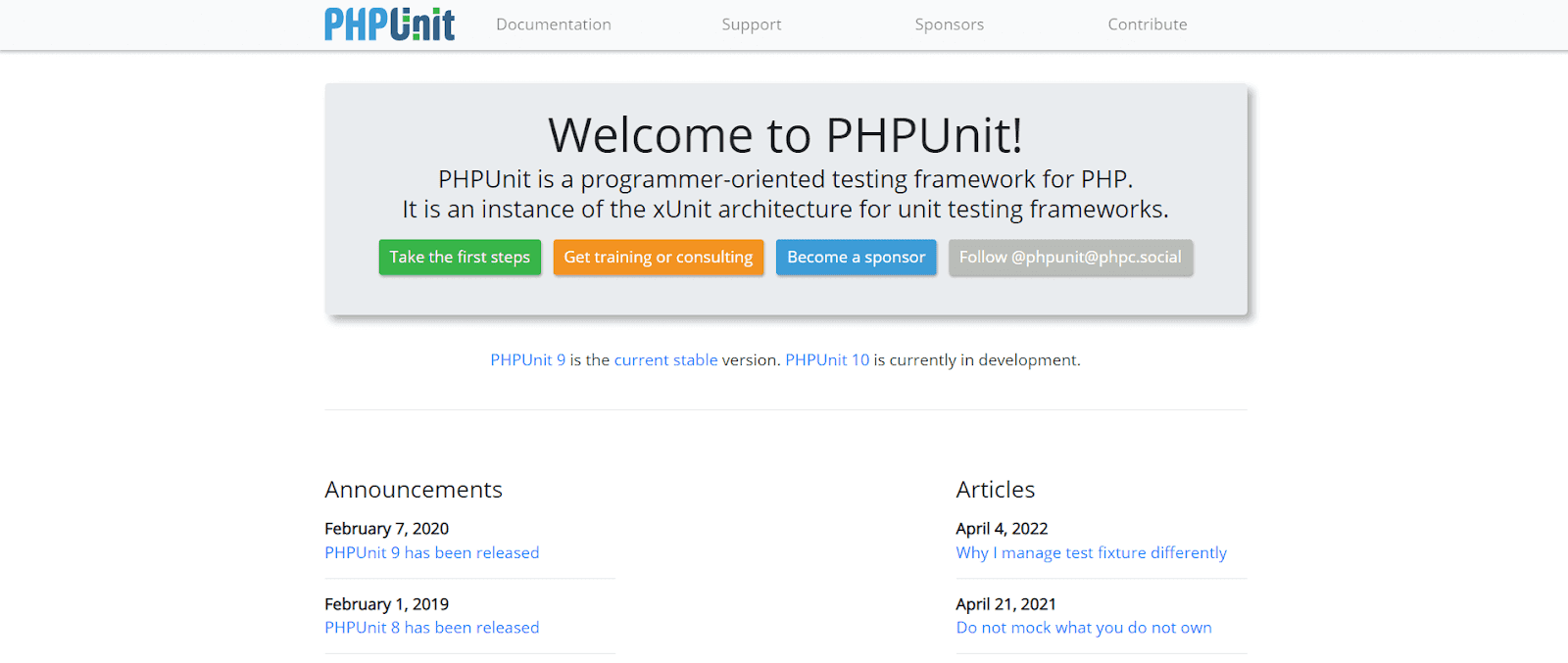
PHPUnit, a widely-used automation testing framework for PHP, offers built-in support for several programming languages and technologies, such as YAML, XML, and Markdown through its MarkdownTestSuite. This feature allows developers to write tests using these formats, making working with different data types.
Additionally, PHPUnit can fetch information from various sources, including databases, XML files, and JSON, enabling developers to test their applications more comprehensively. This flexibility in data retrieval helps in creating more thorough and effective tests for PHP applications.
Eye-catching Features of PHPUnit:
- It allows you to quickly find problems in the development stage.
- It executes code refactoring or framework library upgrades with ease.
- It incorporates Agile methodologies and principles while meeting functional requirements.
Geb
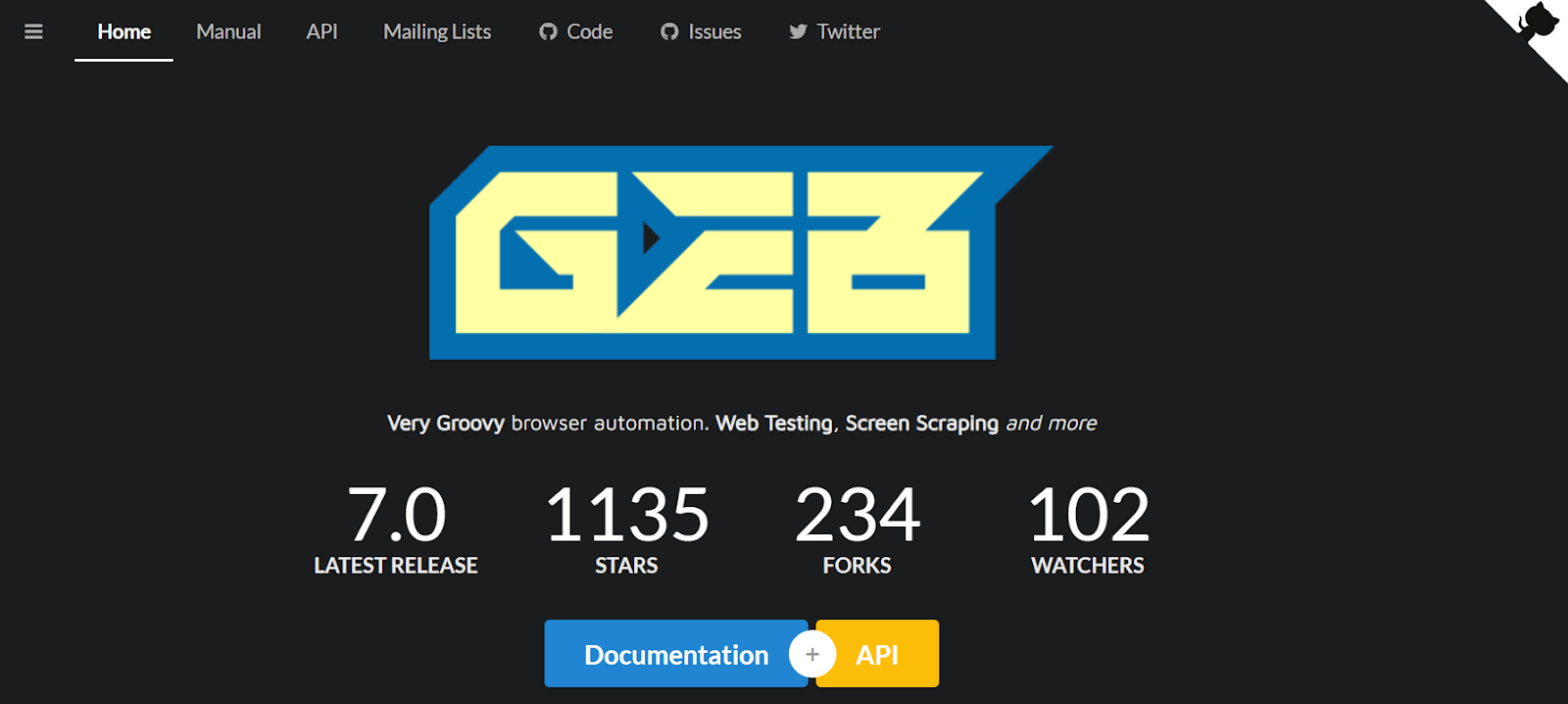
Geb is a Groovy-based web test automation framework known for its extensive feature set that simplifies the creation, execution, and maintenance of web tests. It is highly regarded for its robust capabilities, making it a versatile choice for testing various types of web applications. It is a powerful and flexible framework offering many features to streamline the web testing process. Its ease of use and robust capabilities make it a popular choice among developers for testing web applications.
Eye-catching Features of Geb:
- It allows you to write tests using a concise and readable syntax, making it easier to understand and maintain your test code.
- It promotes using page objects, which help create more modular and maintainable test code by separating the test logic from the page structure.
- It seamlessly integrates with WebDriver, allowing you to use WebDriver’s powerful features for interacting with web elements.
- It provides built-in support for handling Ajax requests and executing JavaScript, making it easier to test applications that heavily rely on these technologies.
- It offers comprehensive documentation that covers all aspects of the framework, making it easier for new users to get started and for experienced users to dive deeper into advanced topics.
Serenity BDD

Serenity (also known as Serenity BDD) is an open-source automation testing framework designed for regression and acceptance testing. It is widely used as an automation testing framework because it can improve the quality and maintainability of automated acceptance tests. It enhances the quality and maintainability of automated acceptance tests. Its support for BDD practices, detailed reporting, and seamless integration with popular tools make it a popular choice among teams looking to improve their automated testing processes.
Eye-catching Features of Serenity BDD:
- It supports Behavior-Driven Development (BDD) practices, allowing teams to write tests in a more human-readable format using Given-When-Then scenarios.
- It provides detailed and easy-to-understand test reports; these reports help identify issues quickly and improve the overall quality of the application.
- It integrates seamlessly with popular tools such as JUnit, TestNG, Cucumber, and Selenium, making it easy to incorporate into existing testing workflows.
- It promotes Page Objects, which help create more maintainable and reusable test code by separating the test logic from the page structure.
- It supports parallel execution of tests, allowing teams to run tests faster and improve test efficiency.
Behat
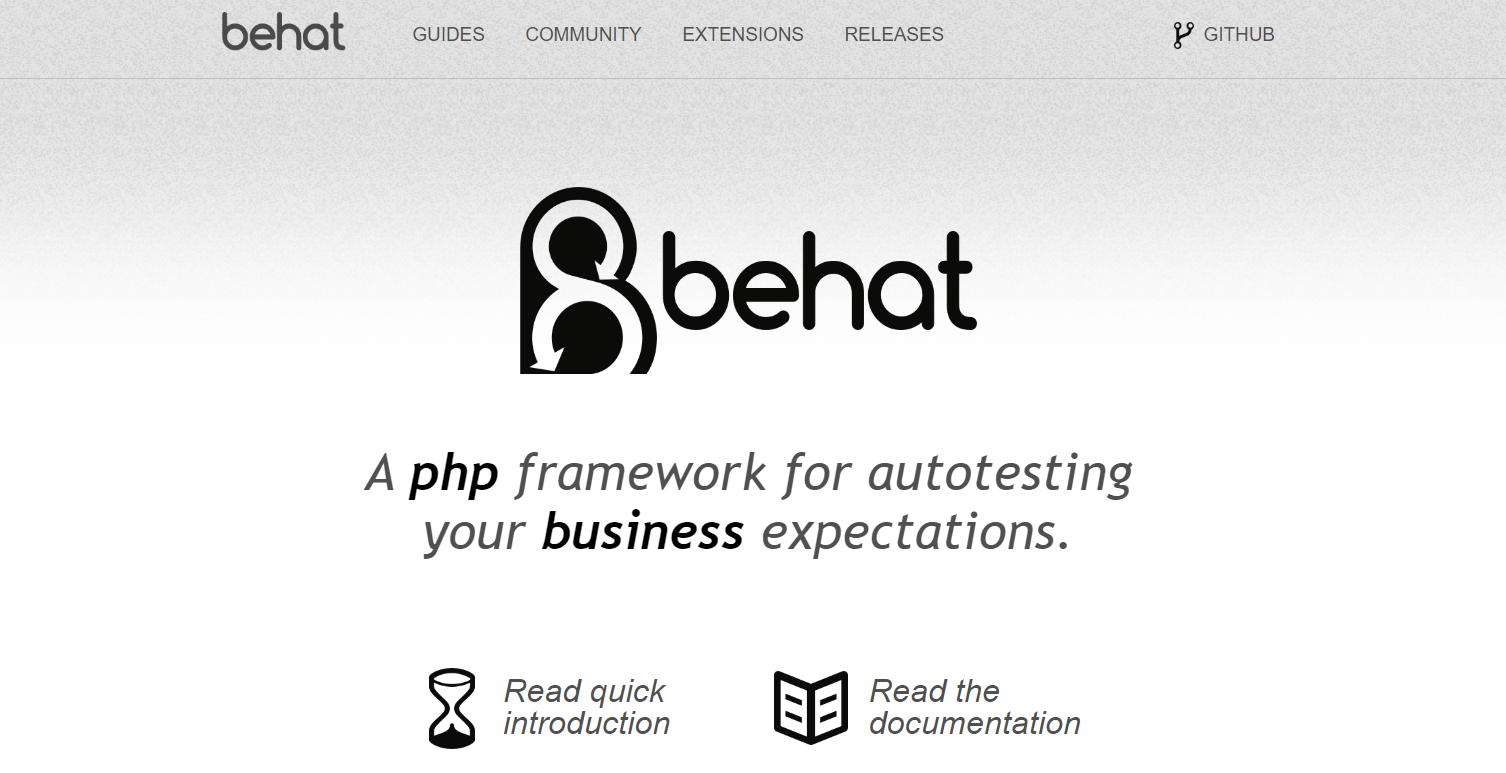
Behat is a behavior-driven development framework designed for PHP. It facilitates the behavior-driven development process by allowing requirements to be expressed in a natural language format understandable by non-technical stakeholders and developers.
Eye-catching Features of Behat:
- It uses Gherkin syntax to describe test scenarios.
- It integrates with Mink, a browser automation and testing tool, which allows you to write tests that interact with your web application.
- It uses contexts to provide a way to share state and behavior across step definitions. This allows for better organization of code and reusability of step definitions.
- It is highly extensible, allowing users to add custom functionality through extensions. This makes it possible to tailor Behat to specific project requirements.
RSpec
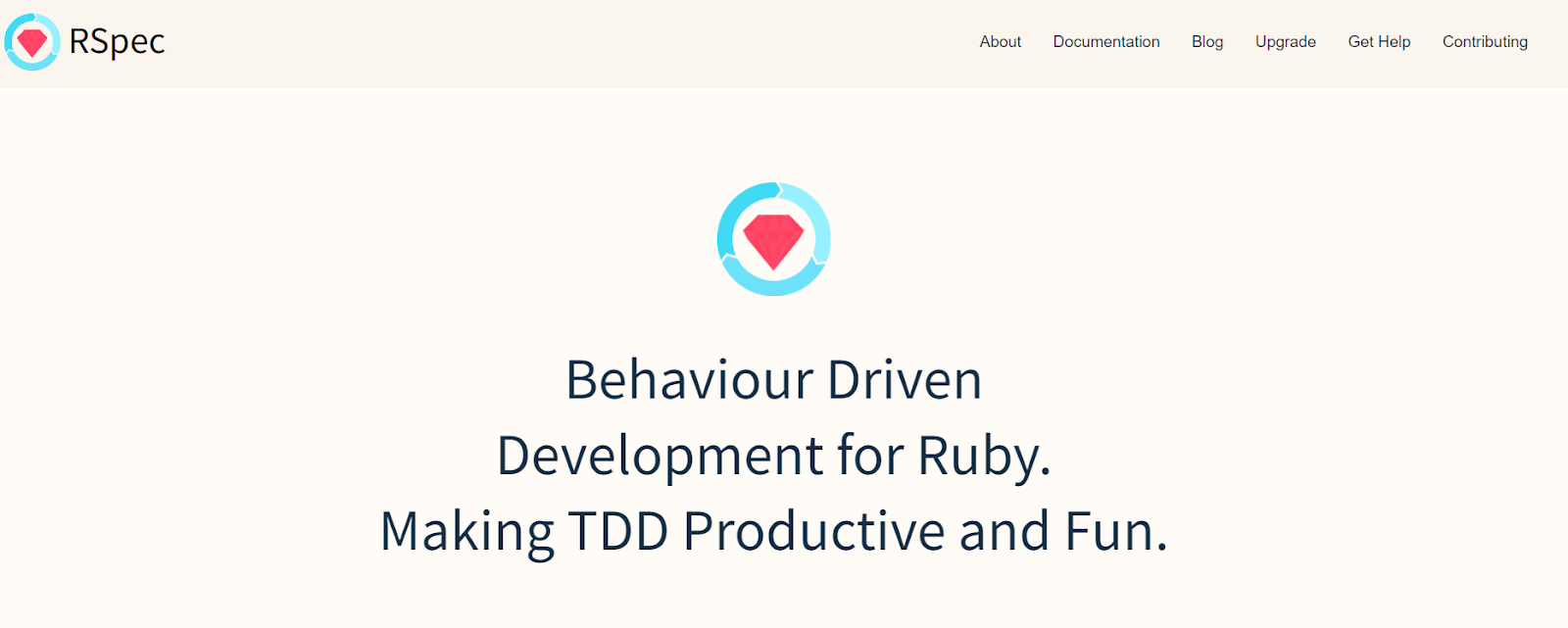
RSpec is an automation testing framework designed to make writing and maintaining tests easier and more intuitive. It is commonly used for behavior-driven development in Ruby projects.
Eye-catching Features of RSpec:
- It uses a clear and expressive syntax that closely mirrors the natural language used to describe behavior. This makes it easy to understand tests, even for non-technical stakeholders.
- It provides a framework for writing descriptive specifications of the behavior of your code, known as examples.
- It includes a library of matchers that allow you to make assertions about the state of your code in a readable and expressive way.
Test::Unit
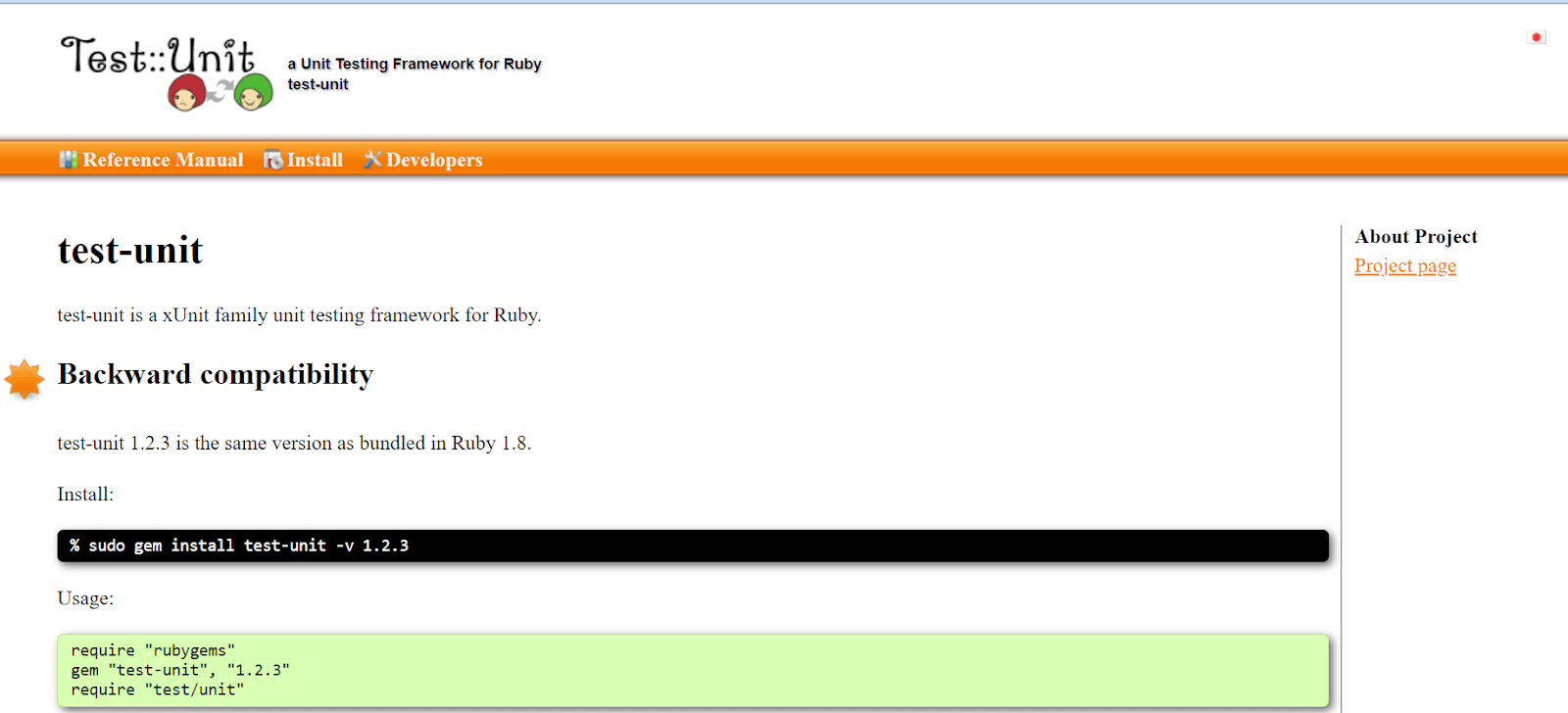
Test::Unit is a unit testing framework for the Ruby programming language included in the Ruby Standard Library. It enables developers to write and execute automated tests for Ruby code.
Inspired by the xUnit family of testing frameworks, which includes JUnit for Java and NUnit for .NET, It follows a similar structure and approach to writing tests. This familiarity makes it easier for developers with these frameworks to start writing tests in Ruby using Test::Unit.
It provides assertion methods to verify expected outcomes and supports test fixtures for setting preconditions and cleaning up after tests. It is a simple yet effective tool for writing and running unit tests in Ruby.
Eye-catching Features of Test::Unit:
- It allows the grouping of tests into suites. A suite is a collection of test cases that can be executed together.
- It includes a test runner that facilitates the execution of test suites and provides formatted output of test results.
- It can be integrated with continuous integration tools, making it valuable in a CI/CD pipeline.
SpecFlow
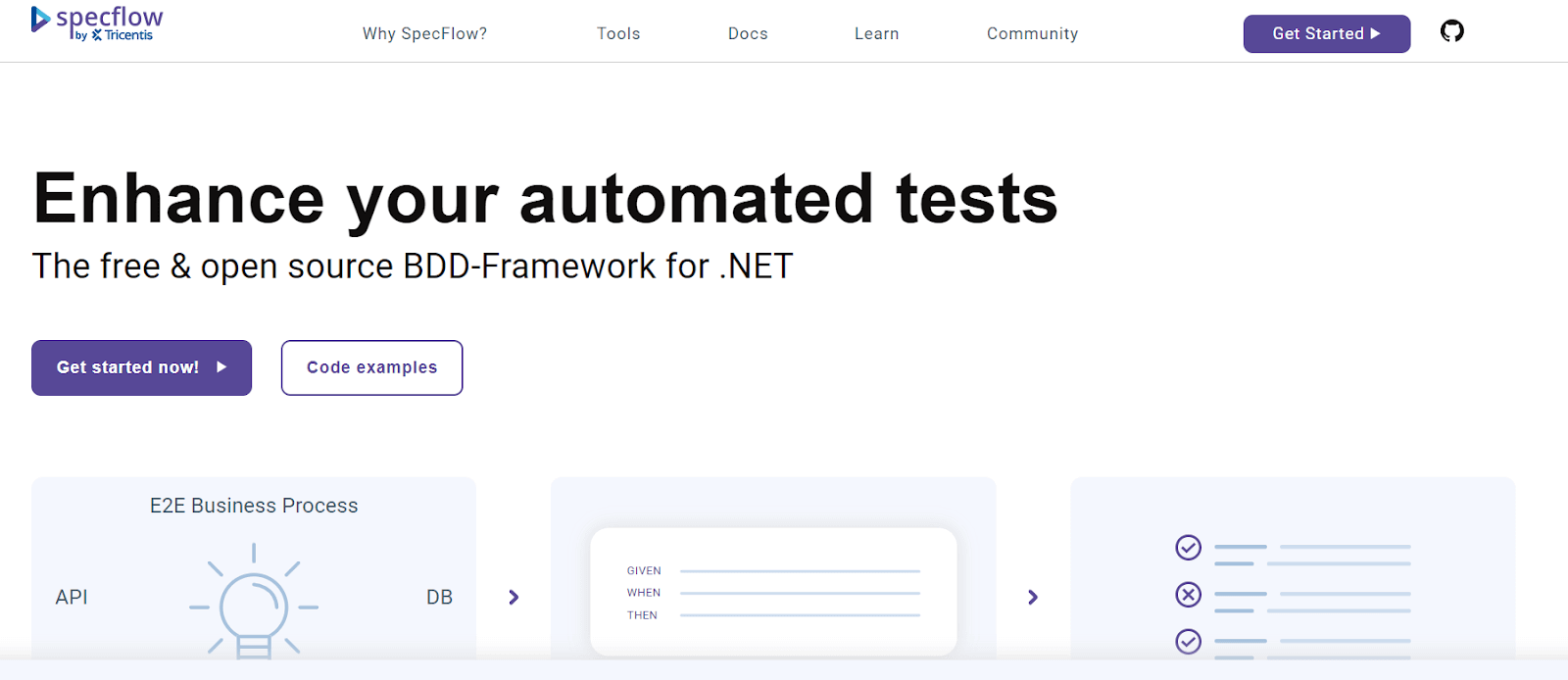
SpecFlow is a behavior-driven development and acceptance testing framework for .NET applications. It encourages collaboration among stakeholders by enabling the expression of software requirements in natural language. It integrates with popular .NET testing frameworks, supports the Gherkin syntax, and emphasizes collaboration, making it a valuable tool for teams looking to improve their testing processes.
Eye-catching Features of SpecFlow:
- It uses the Gherkin language, a plain-text language with a predefined syntax that allows non-technical stakeholders to write human-readable specifications.
- It provides reporting mechanisms to visualize test results.
- It supports plugins that extend its functionality. Plugins can integrate with continuous integration tools, generate documentation, and more.
- It allows developers to define step definitions that map the natural language statements in feature files to executable code. This helps in automating the testing process based on the specified requirements.
- It provides detailed reports and documentation, making it easier to track the progress of tests and ensure that all requirements are being met.
Capybara

It is the popular automation testing framework written in Ruby, designed to simplify web testing by simulating user interactions with web applications. It excels in creating and executing scenarios for various user stories, making it a valuable tool for automated web testing.
Its notable feature is its ability to mimic user actions, such as parsing HTML, navigating through pages, and interacting with forms. It supports multiple WebDrivers, including RackTest, Selenium, and Capybara-WebKit, providing flexibility in testing different types of web applications.
Eye-catching Features of Capybara:
- It offers a user-friendly API for simulating user interactions with web applications, making writing and maintaining tests easy.
- It supports multiple WebDrivers, ensuring compatibility with various web applications.
- It provides powerful features for writing complex web tests, including JavaScript, frames, and cookies support.
- Its integration with Rack::Test provides a simple and clean interface for test execution.
- Locating elements in the Document Object Model (DOM) is straightforward with Capybara, facilitating actions like clicking links and buttons.
MSTest
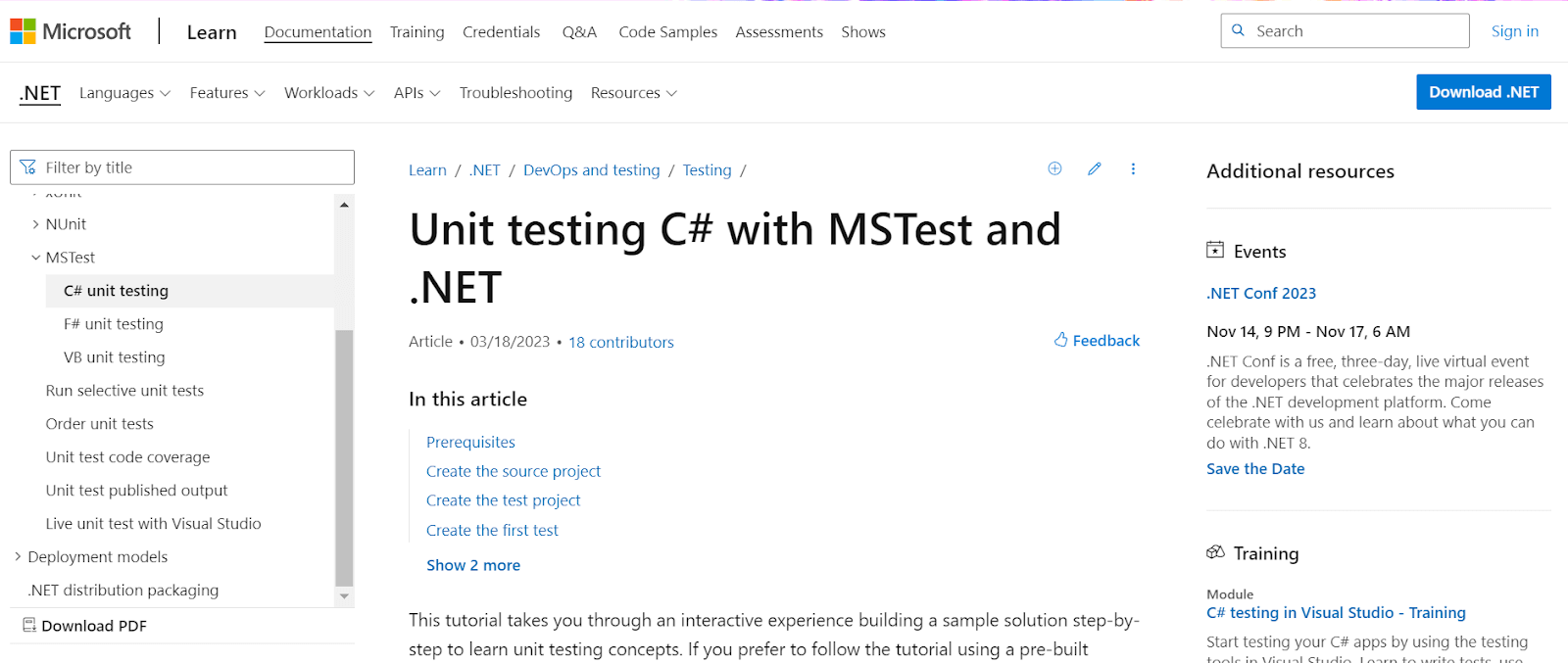
MSTest is a unit testing framework developed by Microsoft for testing .NET applications, particularly those written in languages such as C# and VB.NET. It provides a way to write and run automated tests to ensure the correctness of the software under test.
Eye-catching Features of MSTest:
- It is tightly integrated with Microsoft Visual Studio, making it easy for developers to create, manage, and run tests directly from the IDE.
- It provides various assertion methods like Assert.AreEqual, Assert.IsTrue, Assert.IsFalse, etc., for validating expected outcomes in test methods.
- It uses attributes to mark methods as test, setup, and teardown methods, making it easy to organize and manage tests.
- It provides assertion methods to verify expected outcomes, helping developers quickly identify and fix issues in their code.
Behave
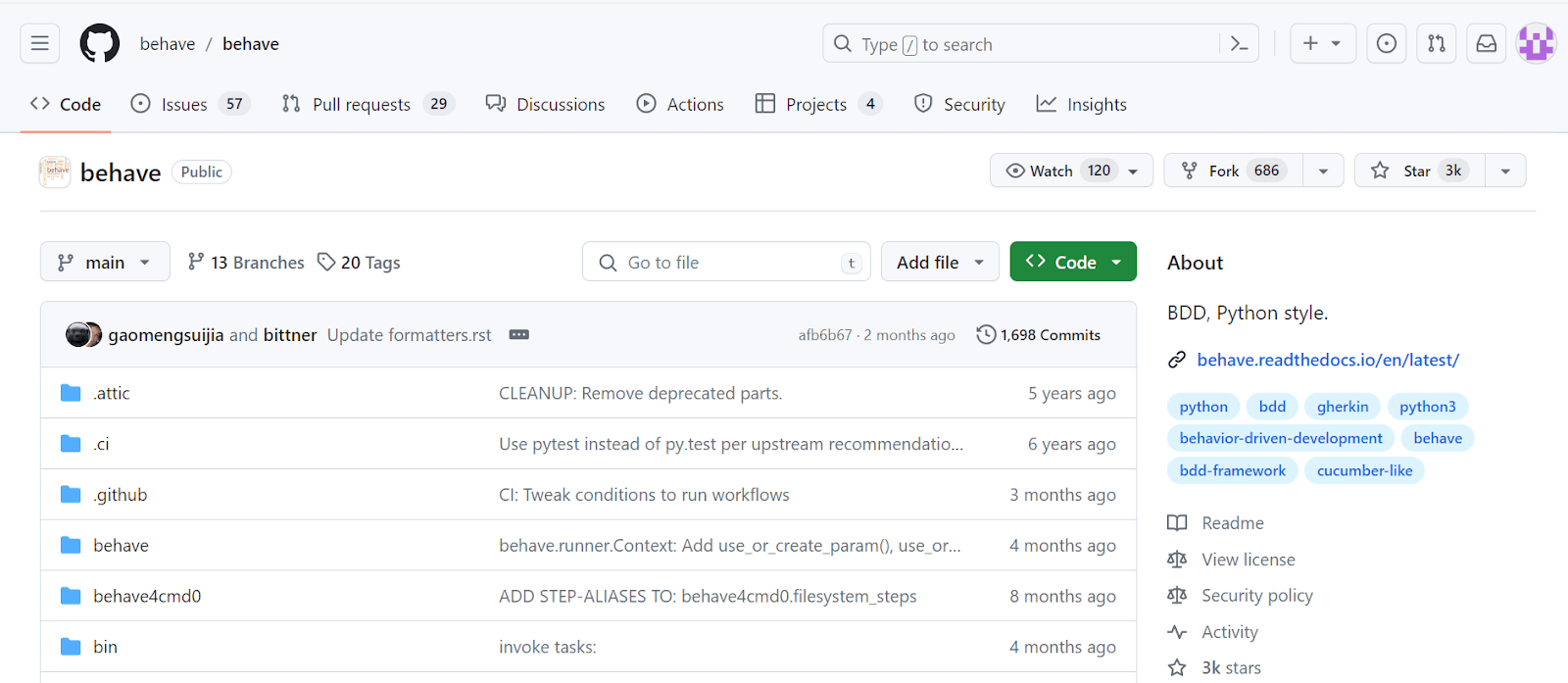
It is a behavior-driven development framework for Python commonly used for automated testing. BDD promotes collaboration between developers, QA, and non-technical stakeholders through natural language specifications. It allows you to write tests in a human-readable format, making it easier for stakeholders to understand and contribute to the testing process.
Eye-catching Features of Behave:
- It is primarily designed for Python and integrates seamlessly with Python projects.
- It allows the use of tags to categorize and organize scenarios.
- It is commonly used with Selenium for web application testing and other tools for API testing.
unittest
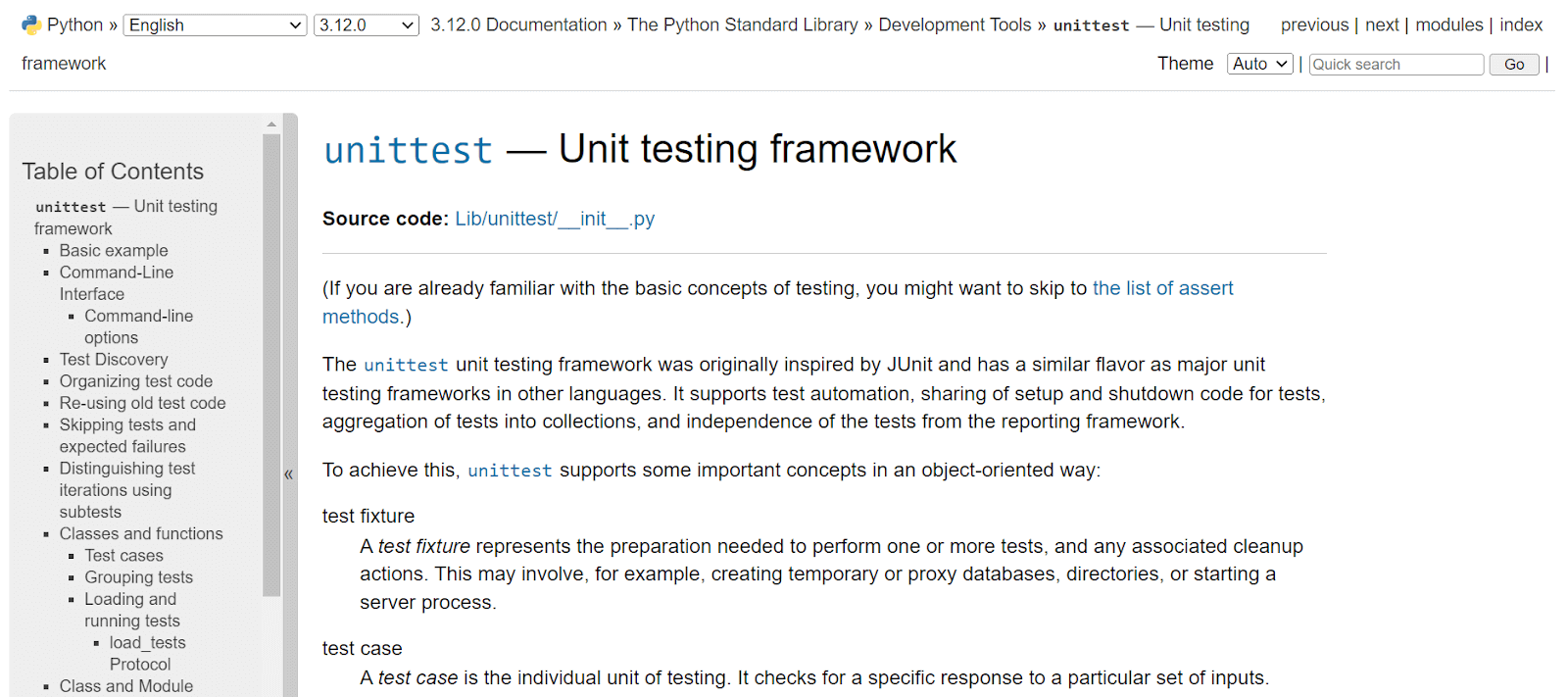
unittest is an automation testing framework included in the standard library. It is inspired by the unit testing frameworks of other programming languages like Java and C++. unittest provides a robust set of tools and features for writing and running tests, making it easier to test Python code.
Eye-catching Features of unittest:
- It can automatically discover tests in your codebase, making running all tests with a single command easy.
- It supports fixtures, which are functions that set up the testing environment before each test and clean up after each test.
- It provides many assertion methods for verifying that your code behaves as expected.
Lettuce
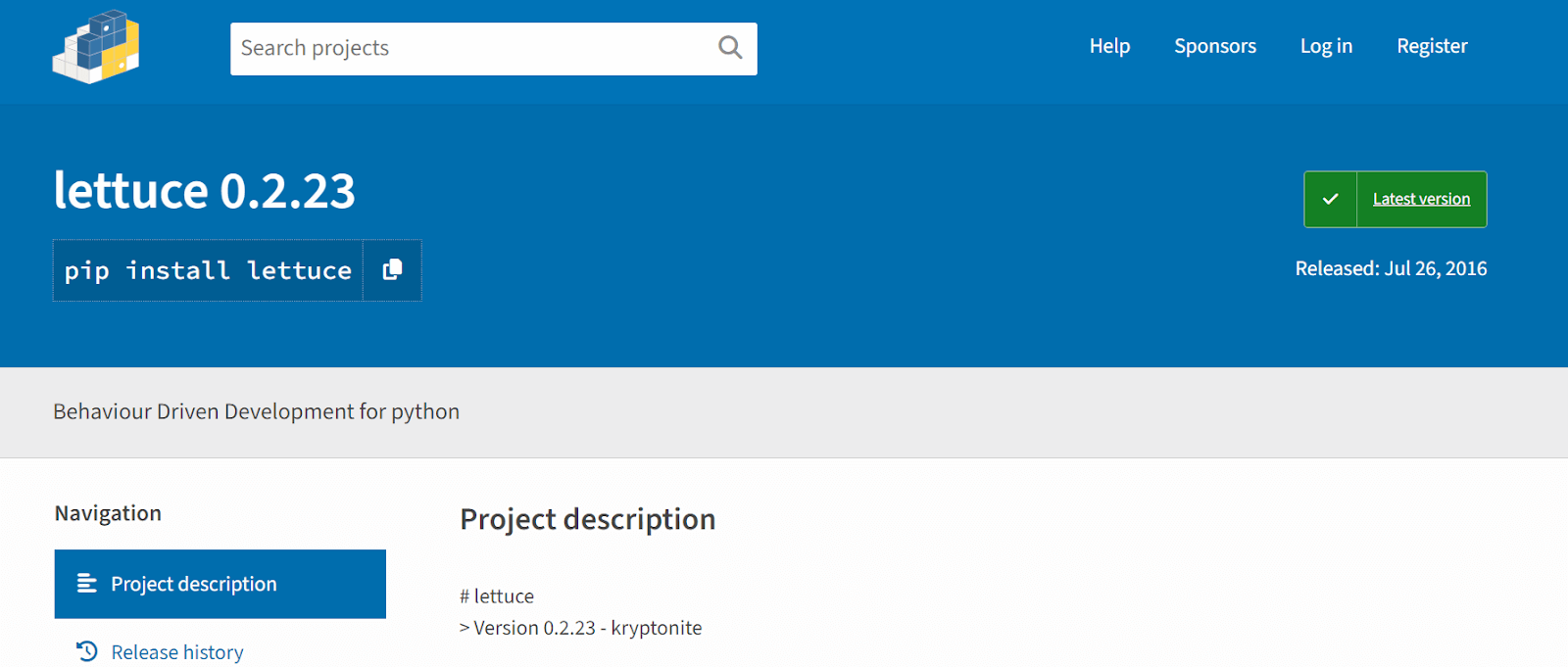
It is a Python-based automation testing framework primarily used for behavior-driven development (BDD) with the Gherkin language. Gherkin is a simple, human-readable language that allows developers to describe how software should behave in plain text.
Eye-catching Features of Lettuce:
- It allows developers to define step definitions that map the natural language statements in feature files to executable code. This helps in automating the testing process based on the specified requirements.
- It supports the use of test fixtures, which are functions that set up the testing environment before each test and clean up after each test.
- It provides detailed test reports, making it easy to track the progress of tests and identify any issues that need to be addressed.
Karma
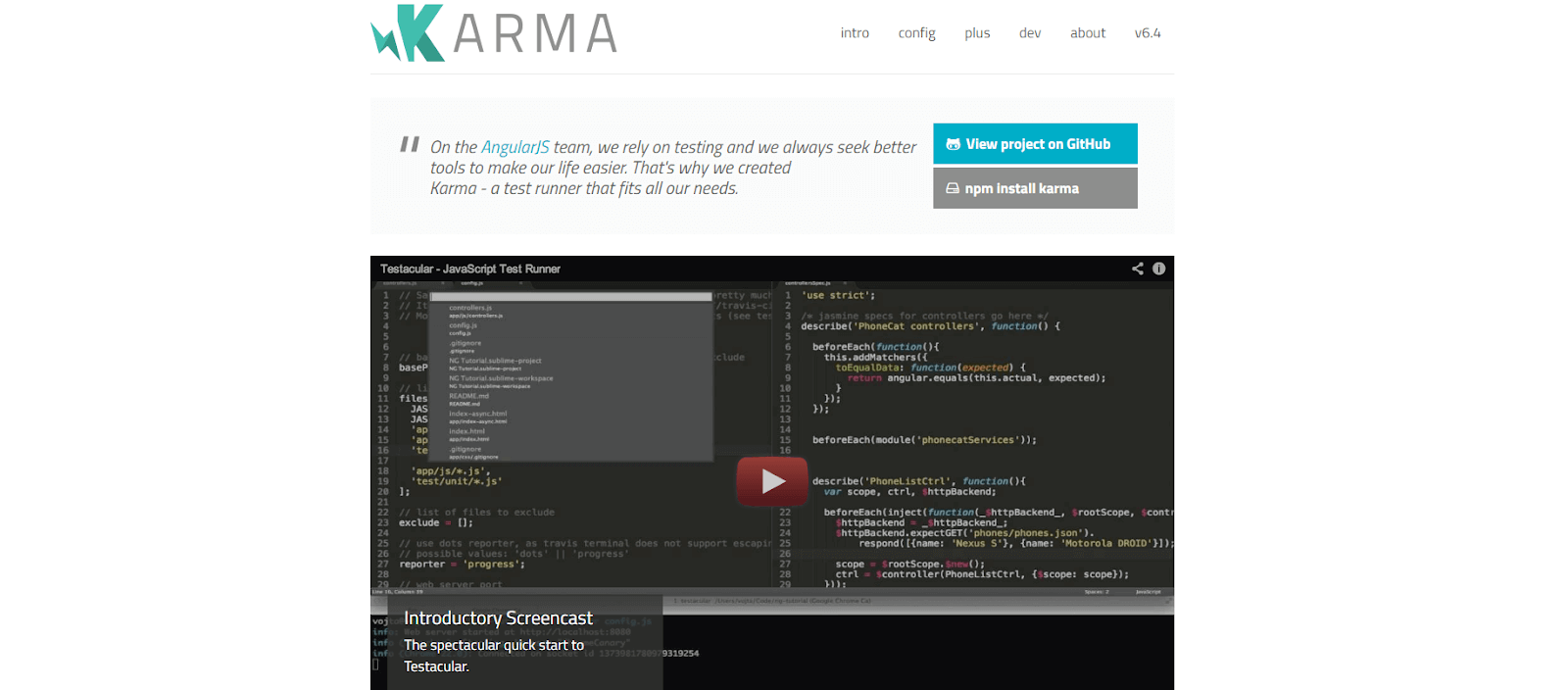
Karma is an open-source automation testing framework that is primarily used for automating unit testing in web applications. It works with various testing frameworks such as Jasmine, Mocha, and QUnit, allowing developers to run tests in multiple browsers simultaneously.
It is a versatile test runner for JavaScript that simplifies automating unit testing in web applications. Its ability to work with multiple testing frameworks and browsers makes it a valuable tool for web developers looking to ensure the quality and reliability of their code.
Eye-catching Features of Karma:
- It allows you to run tests in multiple browsers simultaneously, making ensuring compatibility across different browser environments easier.
- It is designed to work well with continuous integration (CI) tools, making it easy to incorporate automated testing into your development workflow.
- It provides real-time feedback on test results, making it easy to identify and fix issues quickly.
Nemo.js
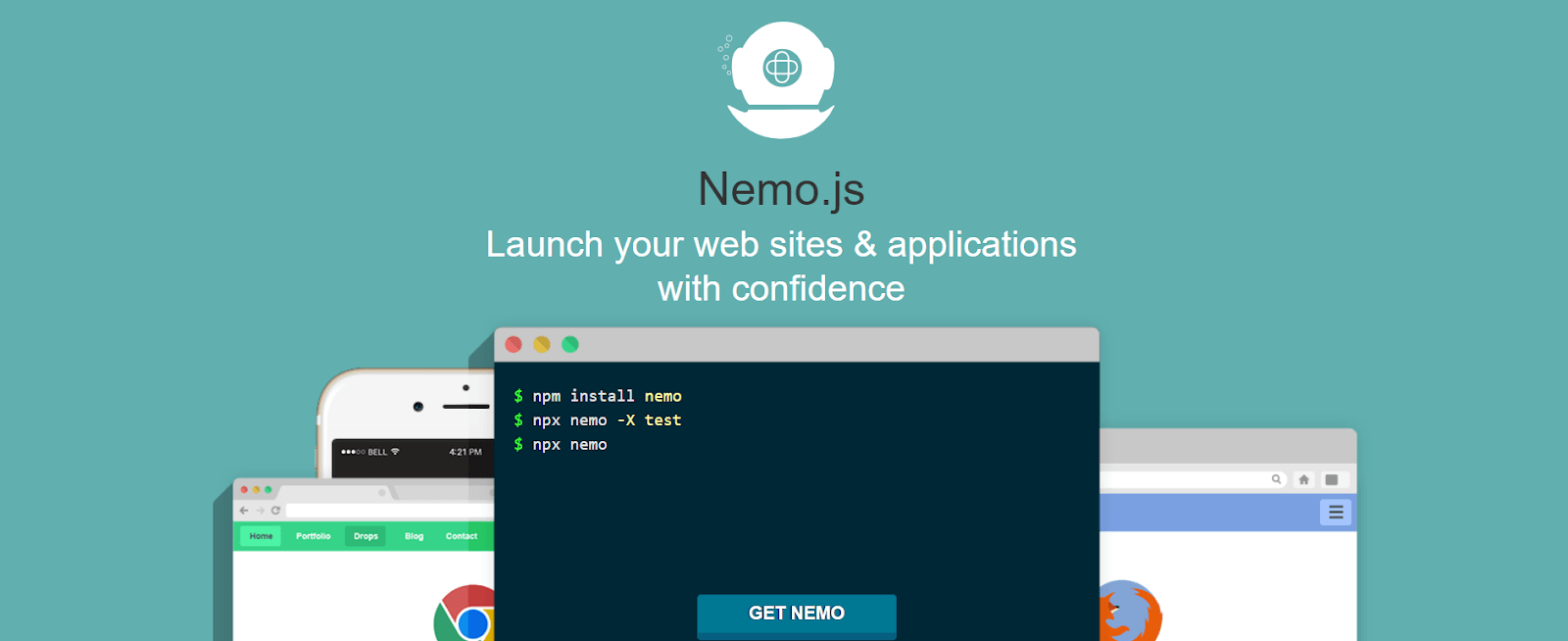
Nemo.js is an open-source automation testing framework offering a range of features that simplify the process of writing, executing, and maintaining web tests. It is built on top of Selenium, leveraging its capabilities to interact with web elements and simulate user interactions.
Eye-catching Features of Nemo.js:
- It provides a robust implementation of the Page Object Model, making creating reusable and maintainable test code easier.
- It has a plugin architecture that allows you to extend its functionality easily. You can create custom plugins to add new features or integrate with other tools and services.
- It can automatically capture screenshots during test execution, making it easier to debug test failures and understand the test execution flow.
Testing on Cloud With Different Frameworks at Scale
To run automated tests at scale effectively, choosing between local and cloud grids is crucial. While local grids can be time-consuming, expensive, and challenging to set up and maintain, cloud testing offers a solution.
Cloud testing platforms, such as LambdaTest, provide access to a large and scalable infrastructure of devices and browsers. This eliminates the need to set up and maintain your grid and ensures reliability and support for complex testing processes.
LambdaTest is an AI-powered test orchestration and execution platform that lets you run manual and automated tests at scale with over 3000+ real devices, browsers, and OS combinations. It supports various test automation frameworks, including Selenium, Cypress, Playwright, and Appium.
Why consider LambdaTest?
- It supports parallel testing, enabling you to run multiple tests simultaneously across different browsers and devices. This can significantly reduce the time it takes to execute your tests.
- It integrates seamlessly with best test automation frameworks, allowing you to start testing your application quickly and easily.
- It provides advanced debugging tools, such as video recording, network logs, and console logs, which can help you identify and fix bugs quickly.
- It offers a scalable mobile device lab with thousands of real Android and iOS devices, allowing you to test your mobile applications on various devices.
Wrapping It Up!
To sum up, a wide range of automation testing frameworks are on the market today, each with unique testing needs and scenarios. Whether you’re looking to increase efficiency and reduce costs or you’d like to ensure full test coverage and a consistent testing approach, these frameworks play an important role in the success and longevity of your software development efforts.
As technology evolves, choosing the right framework for your project’s specific needs and the team’s expertise is important as technology evolves as technology evolves. Not only does embracing these frameworks streamline the testing process, but it also significantly improves the overall success of your software projects.
Happy Testing!
Frequently Asked Questions (FAQs)
What is a framework in automation testing?
A framework in automation testing is a set of guidelines and standards that provide a structure for designing and executing automated tests. It helps to improve the efficiency and consistency of the testing process by organizing test cases, reducing maintenance efforts, and enhancing reusability. The purpose of a framework is to provide a well-defined, repeatable process for automated testing that helps to ensure the quality of software applications.
Is Cucumber a framework?
One such open-source tool that encourages behavior-driven development is Cucumber. Cucumber can be formally described as a testing framework driven by plain English text. It functions simultaneously as development support, automated testing, and documentation.
What type of framework is TestNG?
An open-source framework for test automation in Java is called TestNG. It was created similarly to how JUnit and NUnit were. When compared to its competitors, TestNG is a more robust framework due to a few of its advanced and practical capabilities.
How do I choose an automation testing framework?
When choosing an Automation Testing Framework, consider factors like your team’s expertise, the languages and tools you currently use, the complexity of your application, and the framework’s integration capabilities with your existing workflow. It’s important to select a framework that aligns with your project requirements and enhances your team’s efficiency in automation testing.
What is the most popular automation testing framework?
Selenium is considered one of the best automation testing frameworks. It is an open-source framework with a suite of tools that allows you to write test scripts in multiple programming languages like Ruby, Java, and Node. js, PHP, Perl, Python, JavaScript, C#, and more.
Is Selenium a tool or framework?
Selenium is a tool used within Automation Testing Frameworks for automating web browsers and testing web applications.
How many frameworks are there in automation?
There are six common types of automation testing frameworks, each with a distinctive architecture and set of advantages and downsides. It’s crucial to select the appropriate framework while creating a test strategy.
Got Questions? Drop them on LambdaTest Community. Visit now





